Perceived Fairness, Emotions, and Customer Intentions in Fast Food
VerifiedAdded on 2023/01/24
|26
|13577
|60
Report
AI Summary
This report analyzes a study published in the Gadjah Mada International Journal of Business, investigating the interrelationships among perceived service fairness, emotions, and behavioral intentions within the context of fast food chain restaurants in Indonesia. The research, conducted using Structural Equation Modeling (SEM) on a sample of 800 respondents from major Indonesian cities, explores the impact of price, outcome, and interactional fairness on customers' positive emotions and subsequent behavioral intentions, based on the Mehrabian-Russell model. The study reveals that procedural fairness does not significantly influence positive emotions, while the other fairness dimensions do. The findings offer insights for restaurant managers to develop strategies for enhancing service fairness, customer retention, and financial performance, emphasizing the importance of fairness principles in shaping customer experiences and behavior. The study's limitations are acknowledged, particularly in generalizing the findings to other industries, and highlights the role of emotions in mediating the relationship between perceived fairness and behavioral intentions.
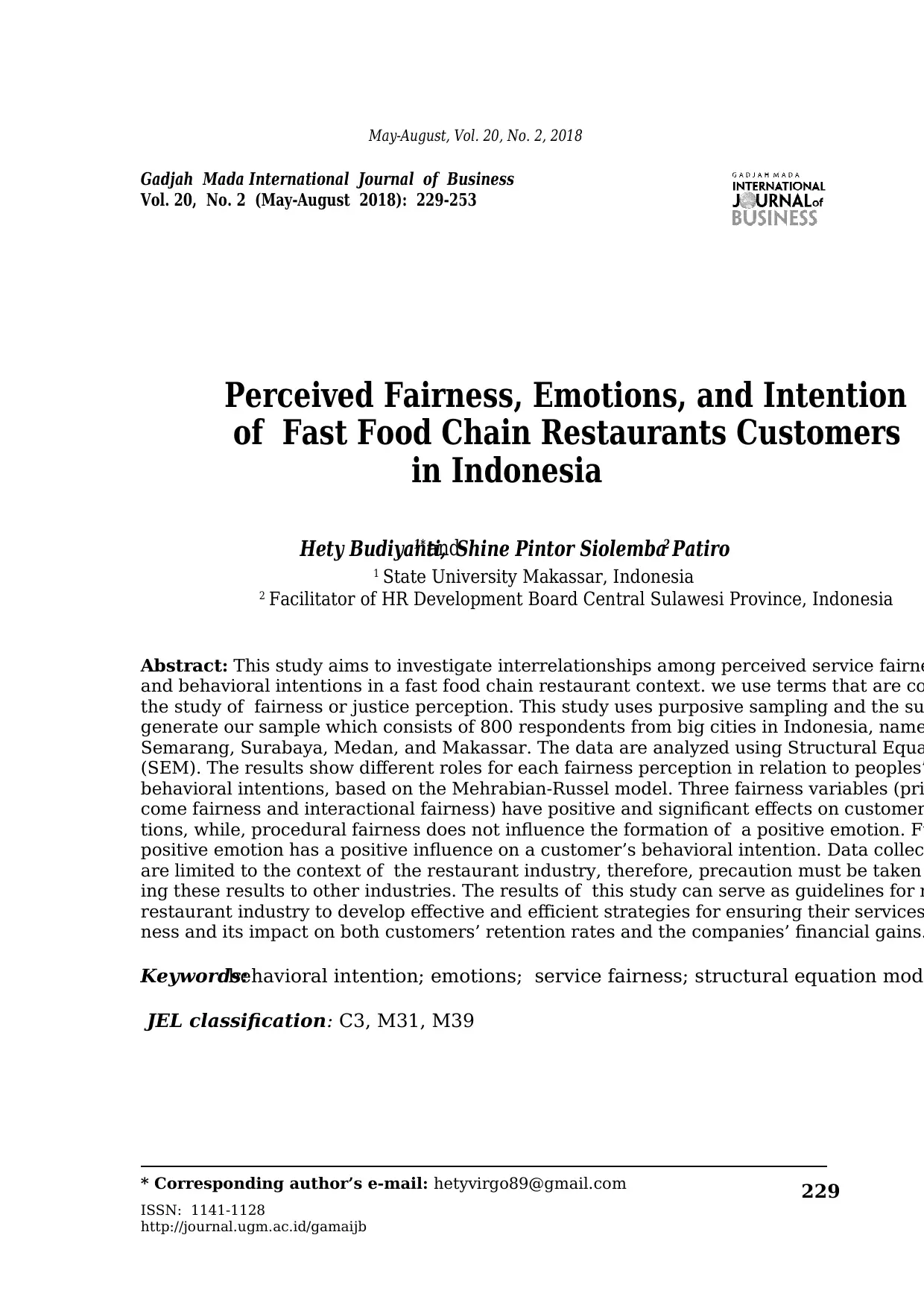
229
Gadjah Mada International Journal of Business– May-August, Vol. 20, No. 2, 2018
Gadjah Mada International Journal of Business
Vol. 20, No. 2 (May-August 2018): 229-253
* Corresponding author’s e-mail: hetyvirgo89@gmail.com
ISSN: 1141-1128
http://journal.ugm.ac.id/gamaijb
Perceived Fairness, Emotions, and Intention
of Fast Food Chain Restaurants Customers
in Indonesia
Hety Budiyanti,1* andShine Pintor Siolemba Patiro2
1 State University Makassar, Indonesia
2 Facilitator of HR Development Board Central Sulawesi Province, Indonesia
Abstract: This study aims to investigate interrelationships among perceived service fairne
and behavioral intentions in a fast food chain restaurant context. we use terms that are co
the study of fairness or justice perception. This study uses purposive sampling and the su
generate our sample which consists of 800 respondents from big cities in Indonesia, name
Semarang, Surabaya, Medan, and Makassar. The data are analyzed using Structural Equa
(SEM). The results show different roles for each fairness perception in relation to peoples’
behavioral intentions, based on the Mehrabian-Russel model. Three fairness variables (pri
come fairness and interactional fairness) have positive and significant effects on customer
tions, while, procedural fairness does not influence the formation of a positive emotion. Fu
positive emotion has a positive influence on a customer’s behavioral intention. Data collec
are limited to the context of the restaurant industry, therefore, precaution must be taken
ing these results to other industries. The results of this study can serve as guidelines for m
restaurant industry to develop effective and efficient strategies for ensuring their services
ness and its impact on both customers’ retention rates and the companies’ financial gains.
Keywords:behavioral intention; emotions; service fairness; structural equation mode
JEL classification: C3, M31, M39
Gadjah Mada International Journal of Business– May-August, Vol. 20, No. 2, 2018
Gadjah Mada International Journal of Business
Vol. 20, No. 2 (May-August 2018): 229-253
* Corresponding author’s e-mail: hetyvirgo89@gmail.com
ISSN: 1141-1128
http://journal.ugm.ac.id/gamaijb
Perceived Fairness, Emotions, and Intention
of Fast Food Chain Restaurants Customers
in Indonesia
Hety Budiyanti,1* andShine Pintor Siolemba Patiro2
1 State University Makassar, Indonesia
2 Facilitator of HR Development Board Central Sulawesi Province, Indonesia
Abstract: This study aims to investigate interrelationships among perceived service fairne
and behavioral intentions in a fast food chain restaurant context. we use terms that are co
the study of fairness or justice perception. This study uses purposive sampling and the su
generate our sample which consists of 800 respondents from big cities in Indonesia, name
Semarang, Surabaya, Medan, and Makassar. The data are analyzed using Structural Equa
(SEM). The results show different roles for each fairness perception in relation to peoples’
behavioral intentions, based on the Mehrabian-Russel model. Three fairness variables (pri
come fairness and interactional fairness) have positive and significant effects on customer
tions, while, procedural fairness does not influence the formation of a positive emotion. Fu
positive emotion has a positive influence on a customer’s behavioral intention. Data collec
are limited to the context of the restaurant industry, therefore, precaution must be taken
ing these results to other industries. The results of this study can serve as guidelines for m
restaurant industry to develop effective and efficient strategies for ensuring their services
ness and its impact on both customers’ retention rates and the companies’ financial gains.
Keywords:behavioral intention; emotions; service fairness; structural equation mode
JEL classification: C3, M31, M39
Paraphrase This Document
Need a fresh take? Get an instant paraphrase of this document with our AI Paraphraser
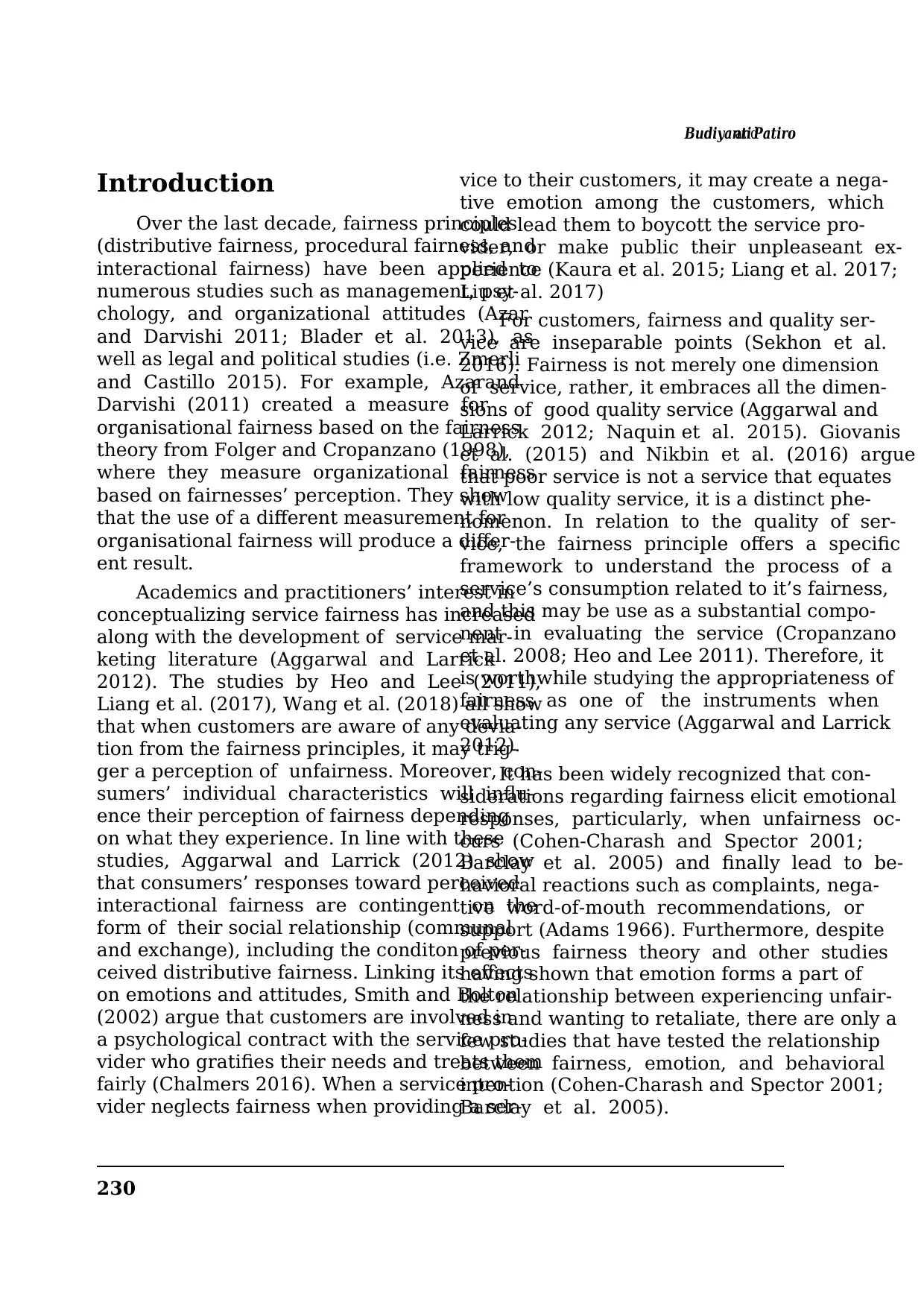
BudiyantiandPatiro
230
Introduction
Over the last decade, fairness principles
(distributive fairness, procedural fairness, and
interactional fairness) have been applied to
numerous studies such as management, psy-
chology, and organizational attitudes (Azar
and Darvishi 2011; Blader et al. 2013), as
well as legal and political studies (i.e. Zmerli
and Castillo 2015). For example, Azarand
Darvishi (2011) created a measure for
organisational fairness based on the fairness
theory from Folger and Cropanzano (1998),
where they measure organizational fairness
based on fairnesses’ perception. They show
that the use of a different measurement for
organisational fairness will produce a differ-
ent result.
Academics and practitioners’ interest in
conceptualizing service fairness has increased
along with the development of service mar-
keting literature (Aggarwal and Larrick
2012). The studies by Heo and Lee (2011),
Liang et al. (2017), Wang et al. (2018) all show
that when customers are aware of any devia-
tion from the fairness principles, it may trig-
ger a perception of unfairness. Moreover, con-
sumers’ individual characteristics will influ-
ence their perception of fairness depending
on what they experience. In line with these
studies, Aggarwal and Larrick (2012) show
that consumers’ responses toward perceived
interactional fairness are contingent on the
form of their social relationship (communal
and exchange), including the conditon of per-
ceived distributive fairness. Linking its effects
on emotions and attitudes, Smith and Bolton
(2002) argue that customers are involved in
a psychological contract with the service pro-
vider who gratifies their needs and treats them
fairly (Chalmers 2016). When a service pro-
vider neglects fairness when providing a ser-
vice to their customers, it may create a nega-
tive emotion among the customers, which
could lead them to boycott the service pro-
vider, or make public their unpleaseant ex-
perience (Kaura et al. 2015; Liang et al. 2017;
Liu et al. 2017)
For customers, fairness and quality ser-
vice are inseparable points (Sekhon et al.
2016). Fairness is not merely one dimension
of service, rather, it embraces all the dimen-
sions of good quality service (Aggarwal and
Larrick 2012; Naquin et al. 2015). Giovanis
et al. (2015) and Nikbin et al. (2016) argue
that poor service is not a service that equates
with low quality service, it is a distinct phe-
nomenon. In relation to the quality of ser-
vice, the fairness principle offers a specific
framework to understand the process of a
service’s consumption related to it’s fairness,
and this may be use as a substantial compo-
nent in evaluating the service (Cropanzano
et al. 2008; Heo and Lee 2011). Therefore, it
is worthwhile studying the appropriateness of
fairness as one of the instruments when
evaluating any service (Aggarwal and Larrick
2012).
It has been widely recognized that con-
siderations regarding fairness elicit emotional
responses, particularly, when unfairness oc-
curs (Cohen-Charash and Spector 2001;
Barclay et al. 2005) and finally lead to be-
havioral reactions such as complaints, nega-
tive word-of-mouth recommendations, or
support (Adams 1966). Furthermore, despite
previous fairness theory and other studies
having shown that emotion forms a part of
the relationship between experiencing unfair-
ness and wanting to retaliate, there are only a
few studies that have tested the relationship
between fairness, emotion, and behavioral
intention (Cohen-Charash and Spector 2001;
Barclay et al. 2005).
230
Introduction
Over the last decade, fairness principles
(distributive fairness, procedural fairness, and
interactional fairness) have been applied to
numerous studies such as management, psy-
chology, and organizational attitudes (Azar
and Darvishi 2011; Blader et al. 2013), as
well as legal and political studies (i.e. Zmerli
and Castillo 2015). For example, Azarand
Darvishi (2011) created a measure for
organisational fairness based on the fairness
theory from Folger and Cropanzano (1998),
where they measure organizational fairness
based on fairnesses’ perception. They show
that the use of a different measurement for
organisational fairness will produce a differ-
ent result.
Academics and practitioners’ interest in
conceptualizing service fairness has increased
along with the development of service mar-
keting literature (Aggarwal and Larrick
2012). The studies by Heo and Lee (2011),
Liang et al. (2017), Wang et al. (2018) all show
that when customers are aware of any devia-
tion from the fairness principles, it may trig-
ger a perception of unfairness. Moreover, con-
sumers’ individual characteristics will influ-
ence their perception of fairness depending
on what they experience. In line with these
studies, Aggarwal and Larrick (2012) show
that consumers’ responses toward perceived
interactional fairness are contingent on the
form of their social relationship (communal
and exchange), including the conditon of per-
ceived distributive fairness. Linking its effects
on emotions and attitudes, Smith and Bolton
(2002) argue that customers are involved in
a psychological contract with the service pro-
vider who gratifies their needs and treats them
fairly (Chalmers 2016). When a service pro-
vider neglects fairness when providing a ser-
vice to their customers, it may create a nega-
tive emotion among the customers, which
could lead them to boycott the service pro-
vider, or make public their unpleaseant ex-
perience (Kaura et al. 2015; Liang et al. 2017;
Liu et al. 2017)
For customers, fairness and quality ser-
vice are inseparable points (Sekhon et al.
2016). Fairness is not merely one dimension
of service, rather, it embraces all the dimen-
sions of good quality service (Aggarwal and
Larrick 2012; Naquin et al. 2015). Giovanis
et al. (2015) and Nikbin et al. (2016) argue
that poor service is not a service that equates
with low quality service, it is a distinct phe-
nomenon. In relation to the quality of ser-
vice, the fairness principle offers a specific
framework to understand the process of a
service’s consumption related to it’s fairness,
and this may be use as a substantial compo-
nent in evaluating the service (Cropanzano
et al. 2008; Heo and Lee 2011). Therefore, it
is worthwhile studying the appropriateness of
fairness as one of the instruments when
evaluating any service (Aggarwal and Larrick
2012).
It has been widely recognized that con-
siderations regarding fairness elicit emotional
responses, particularly, when unfairness oc-
curs (Cohen-Charash and Spector 2001;
Barclay et al. 2005) and finally lead to be-
havioral reactions such as complaints, nega-
tive word-of-mouth recommendations, or
support (Adams 1966). Furthermore, despite
previous fairness theory and other studies
having shown that emotion forms a part of
the relationship between experiencing unfair-
ness and wanting to retaliate, there are only a
few studies that have tested the relationship
between fairness, emotion, and behavioral
intention (Cohen-Charash and Spector 2001;
Barclay et al. 2005).
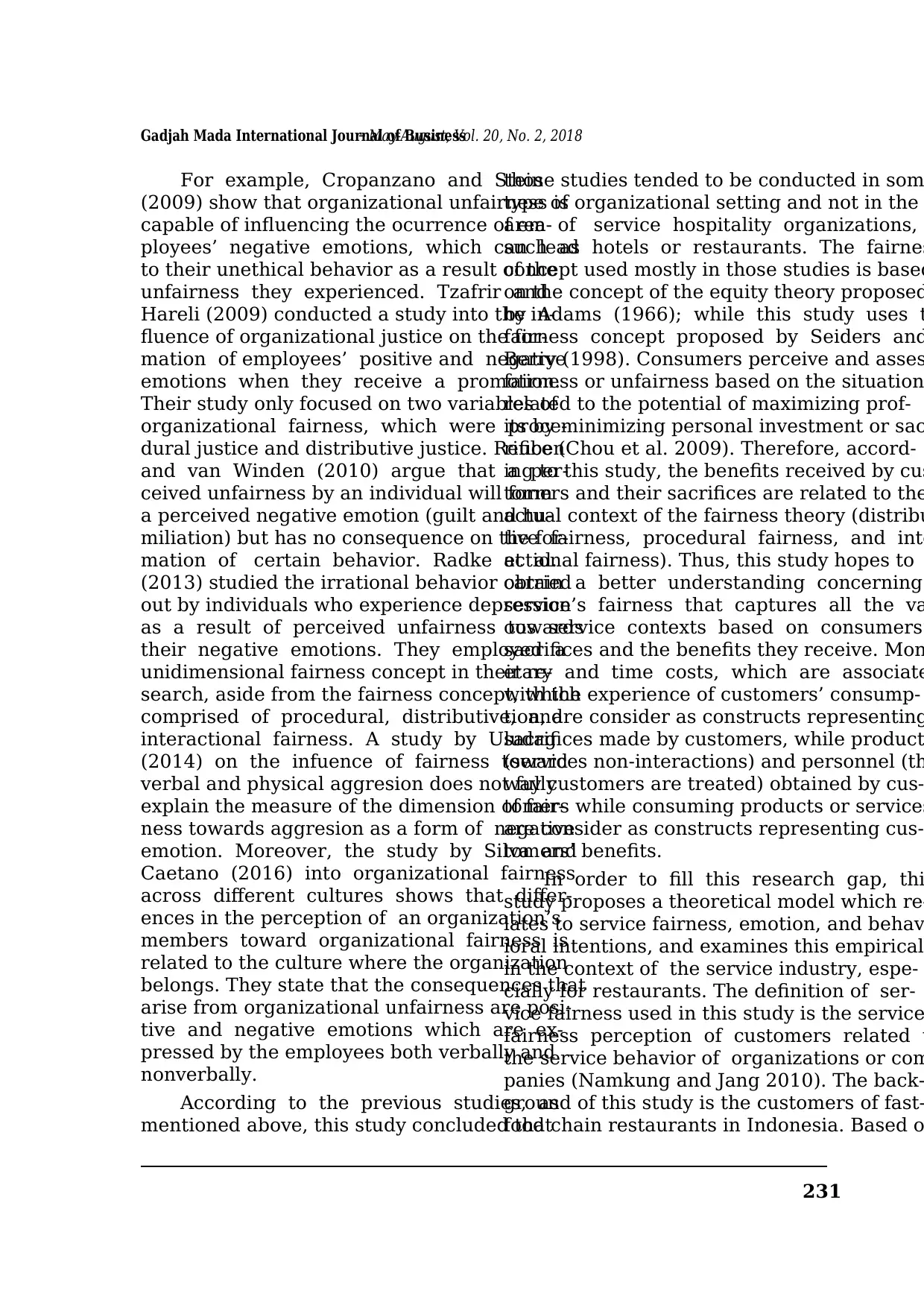
231
Gadjah Mada International Journal of Business– May-August, Vol. 20, No. 2, 2018
For example, Cropanzano and Stein
(2009) show that organizational unfairness is
capable of influencing the ocurrence of em-
ployees’ negative emotions, which can lead
to their unethical behavior as a result of the
unfairness they experienced. Tzafrir and
Hareli (2009) conducted a study into the in-
fluence of organizational justice on the for-
mation of employees’ positive and negative
emotions when they receive a promotion.
Their study only focused on two variables of
organizational fairness, which were proce-
dural justice and distributive justice. Reuben
and van Winden (2010) argue that a per-
ceived unfairness by an individual will form
a perceived negative emotion (guilt and hu-
miliation) but has no consequence on the for-
mation of certain behavior. Radke et al.
(2013) studied the irrational behavior carried
out by individuals who experience depression
as a result of perceived unfairness towards
their negative emotions. They employed a
unidimensional fairness concept in their re-
search, aside from the fairness concept, which
comprised of procedural, distributive, and
interactional fairness. A study by Uludag
(2014) on the infuence of fairness toward
verbal and physical aggresion does not fully
explain the measure of the dimension of fair-
ness towards aggresion as a form of negative
emotion. Moreover, the study by Silva and
Caetano (2016) into organizational fairness
across different cultures shows that differ-
ences in the perception of an organization’s
members toward organizational fairness is
related to the culture where the organization
belongs. They state that the consequences that
arise from organizational unfairness are posi-
tive and negative emotions which are ex-
pressed by the employees both verbally and
nonverbally.
According to the previous studies, as
mentioned above, this study concluded that
those studies tended to be conducted in som
type of organizational setting and not in the
area of service hospitality organizations,
such as hotels or restaurants. The fairnes
concept used mostly in those studies is based
on the concept of the equity theory proposed
by Adams (1966); while this study uses t
fairness concept proposed by Seiders and
Berry (1998). Consumers perceive and asses
fairness or unfairness based on the situation
related to the potential of maximizing prof-
its by minimizing personal investment or sac
rifice (Chou et al. 2009). Therefore, accord-
ing to this study, the benefits received by cus
tomers and their sacrifices are related to the
actual context of the fairness theory (distribu
tive fairness, procedural fairness, and inte
actional fairness). Thus, this study hopes to
obtain a better understanding concerning
service’s fairness that captures all the va
ous service contexts based on consumers’
sacrifices and the benefits they receive. Mon
etary and time costs, which are associate
with the experience of customers’ consump-
tion, are consider as constructs representing
sacrifices made by customers, while product
(services non-interactions) and personnel (th
way customers are treated) obtained by cus-
tomers while consuming products or services
are consider as constructs representing cus-
tomers’ benefits.
In order to fill this research gap, thi
study proposes a theoretical model which re-
lates to service fairness, emotion, and behav
ioral intentions, and examines this empirical
in the context of the service industry, espe-
cially for restaurants. The definition of ser-
vice fairness used in this study is the service
fairness perception of customers related t
the service behavior of organizations or com
panies (Namkung and Jang 2010). The back-
ground of this study is the customers of fast-
food chain restaurants in Indonesia. Based o
Gadjah Mada International Journal of Business– May-August, Vol. 20, No. 2, 2018
For example, Cropanzano and Stein
(2009) show that organizational unfairness is
capable of influencing the ocurrence of em-
ployees’ negative emotions, which can lead
to their unethical behavior as a result of the
unfairness they experienced. Tzafrir and
Hareli (2009) conducted a study into the in-
fluence of organizational justice on the for-
mation of employees’ positive and negative
emotions when they receive a promotion.
Their study only focused on two variables of
organizational fairness, which were proce-
dural justice and distributive justice. Reuben
and van Winden (2010) argue that a per-
ceived unfairness by an individual will form
a perceived negative emotion (guilt and hu-
miliation) but has no consequence on the for-
mation of certain behavior. Radke et al.
(2013) studied the irrational behavior carried
out by individuals who experience depression
as a result of perceived unfairness towards
their negative emotions. They employed a
unidimensional fairness concept in their re-
search, aside from the fairness concept, which
comprised of procedural, distributive, and
interactional fairness. A study by Uludag
(2014) on the infuence of fairness toward
verbal and physical aggresion does not fully
explain the measure of the dimension of fair-
ness towards aggresion as a form of negative
emotion. Moreover, the study by Silva and
Caetano (2016) into organizational fairness
across different cultures shows that differ-
ences in the perception of an organization’s
members toward organizational fairness is
related to the culture where the organization
belongs. They state that the consequences that
arise from organizational unfairness are posi-
tive and negative emotions which are ex-
pressed by the employees both verbally and
nonverbally.
According to the previous studies, as
mentioned above, this study concluded that
those studies tended to be conducted in som
type of organizational setting and not in the
area of service hospitality organizations,
such as hotels or restaurants. The fairnes
concept used mostly in those studies is based
on the concept of the equity theory proposed
by Adams (1966); while this study uses t
fairness concept proposed by Seiders and
Berry (1998). Consumers perceive and asses
fairness or unfairness based on the situation
related to the potential of maximizing prof-
its by minimizing personal investment or sac
rifice (Chou et al. 2009). Therefore, accord-
ing to this study, the benefits received by cus
tomers and their sacrifices are related to the
actual context of the fairness theory (distribu
tive fairness, procedural fairness, and inte
actional fairness). Thus, this study hopes to
obtain a better understanding concerning
service’s fairness that captures all the va
ous service contexts based on consumers’
sacrifices and the benefits they receive. Mon
etary and time costs, which are associate
with the experience of customers’ consump-
tion, are consider as constructs representing
sacrifices made by customers, while product
(services non-interactions) and personnel (th
way customers are treated) obtained by cus-
tomers while consuming products or services
are consider as constructs representing cus-
tomers’ benefits.
In order to fill this research gap, thi
study proposes a theoretical model which re-
lates to service fairness, emotion, and behav
ioral intentions, and examines this empirical
in the context of the service industry, espe-
cially for restaurants. The definition of ser-
vice fairness used in this study is the service
fairness perception of customers related t
the service behavior of organizations or com
panies (Namkung and Jang 2010). The back-
ground of this study is the customers of fast-
food chain restaurants in Indonesia. Based o
⊘ This is a preview!⊘
Do you want full access?
Subscribe today to unlock all pages.

Trusted by 1+ million students worldwide
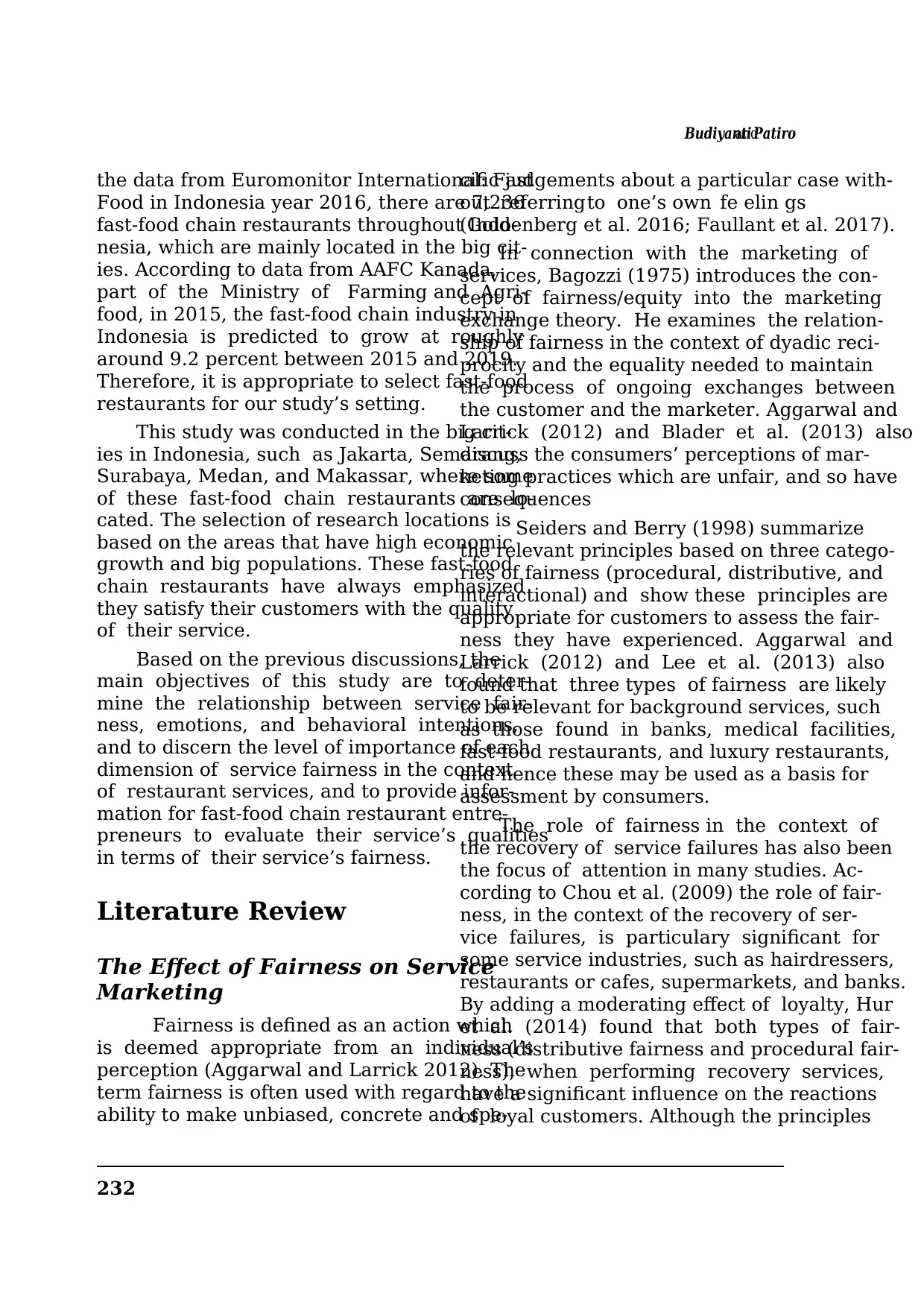
BudiyantiandPatiro
232
the data from Euromonitor International: Fast
Food in Indonesia year 2016, there are 7,236
fast-food chain restaurants throughout Indo-
nesia, which are mainly located in the big cit-
ies. According to data from AAFC Kanada,
part of the Ministry of Farming and Agri-
food, in 2015, the fast-food chain industry in
Indonesia is predicted to grow at roughly
around 9.2 percent between 2015 and 2019.
Therefore, it is appropriate to select fast-food
restaurants for our study’s setting.
This study was conducted in the big cit-
ies in Indonesia, such as Jakarta, Semarang,
Surabaya, Medan, and Makassar, where some
of these fast-food chain restaurants are lo-
cated. The selection of research locations is
based on the areas that have high economic
growth and big populations. These fast-food
chain restaurants have always emphasized
they satisfy their customers with the quality
of their service.
Based on the previous discussions, the
main objectives of this study are to deter-
mine the relationship between service fair-
ness, emotions, and behavioral intentions,
and to discern the level of importance of each
dimension of service fairness in the context
of restaurant services, and to provide infor-
mation for fast-food chain restaurant entre-
preneurs to evaluate their service’s qualities
in terms of their service’s fairness.
Literature Review
The Effect of Fairness on Service
Marketing
Fairness is defined as an action which
is deemed appropriate from an individual’s
perception (Aggarwal and Larrick 2012). The
term fairness is often used with regard to the
ability to make unbiased, concrete and spe-
cific judgements about a particular case with-
out referring to one’s own fe elin gs
(Goldenberg et al. 2016; Faullant et al. 2017).
In connection with the marketing of
services, Bagozzi (1975) introduces the con-
cept of fairness/equity into the marketing
exchange theory. He examines the relation-
ship of fairness in the context of dyadic reci-
procity and the equality needed to maintain
the process of ongoing exchanges between
the customer and the marketer. Aggarwal and
Larrick (2012) and Blader et al. (2013) also
discuss the consumers’ perceptions of mar-
keting practices which are unfair, and so have
consequences
Seiders and Berry (1998) summarize
the relevant principles based on three catego-
ries of fairness (procedural, distributive, and
interactional) and show these principles are
appropriate for customers to assess the fair-
ness they have experienced. Aggarwal and
Larrick (2012) and Lee et al. (2013) also
found that three types of fairness are likely
to be relevant for background services, such
as those found in banks, medical facilities,
fast-food restaurants, and luxury restaurants,
and hence these may be used as a basis for
assessment by consumers.
The role of fairness in the context of
the recovery of service failures has also been
the focus of attention in many studies. Ac-
cording to Chou et al. (2009) the role of fair-
ness, in the context of the recovery of ser-
vice failures, is particulary significant for
some service industries, such as hairdressers,
restaurants or cafes, supermarkets, and banks.
By adding a moderating effect of loyalty, Hur
et al. (2014) found that both types of fair-
ness (distributive fairness and procedural fair-
ness), when performing recovery services,
have a significant influence on the reactions
of loyal customers. Although the principles
232
the data from Euromonitor International: Fast
Food in Indonesia year 2016, there are 7,236
fast-food chain restaurants throughout Indo-
nesia, which are mainly located in the big cit-
ies. According to data from AAFC Kanada,
part of the Ministry of Farming and Agri-
food, in 2015, the fast-food chain industry in
Indonesia is predicted to grow at roughly
around 9.2 percent between 2015 and 2019.
Therefore, it is appropriate to select fast-food
restaurants for our study’s setting.
This study was conducted in the big cit-
ies in Indonesia, such as Jakarta, Semarang,
Surabaya, Medan, and Makassar, where some
of these fast-food chain restaurants are lo-
cated. The selection of research locations is
based on the areas that have high economic
growth and big populations. These fast-food
chain restaurants have always emphasized
they satisfy their customers with the quality
of their service.
Based on the previous discussions, the
main objectives of this study are to deter-
mine the relationship between service fair-
ness, emotions, and behavioral intentions,
and to discern the level of importance of each
dimension of service fairness in the context
of restaurant services, and to provide infor-
mation for fast-food chain restaurant entre-
preneurs to evaluate their service’s qualities
in terms of their service’s fairness.
Literature Review
The Effect of Fairness on Service
Marketing
Fairness is defined as an action which
is deemed appropriate from an individual’s
perception (Aggarwal and Larrick 2012). The
term fairness is often used with regard to the
ability to make unbiased, concrete and spe-
cific judgements about a particular case with-
out referring to one’s own fe elin gs
(Goldenberg et al. 2016; Faullant et al. 2017).
In connection with the marketing of
services, Bagozzi (1975) introduces the con-
cept of fairness/equity into the marketing
exchange theory. He examines the relation-
ship of fairness in the context of dyadic reci-
procity and the equality needed to maintain
the process of ongoing exchanges between
the customer and the marketer. Aggarwal and
Larrick (2012) and Blader et al. (2013) also
discuss the consumers’ perceptions of mar-
keting practices which are unfair, and so have
consequences
Seiders and Berry (1998) summarize
the relevant principles based on three catego-
ries of fairness (procedural, distributive, and
interactional) and show these principles are
appropriate for customers to assess the fair-
ness they have experienced. Aggarwal and
Larrick (2012) and Lee et al. (2013) also
found that three types of fairness are likely
to be relevant for background services, such
as those found in banks, medical facilities,
fast-food restaurants, and luxury restaurants,
and hence these may be used as a basis for
assessment by consumers.
The role of fairness in the context of
the recovery of service failures has also been
the focus of attention in many studies. Ac-
cording to Chou et al. (2009) the role of fair-
ness, in the context of the recovery of ser-
vice failures, is particulary significant for
some service industries, such as hairdressers,
restaurants or cafes, supermarkets, and banks.
By adding a moderating effect of loyalty, Hur
et al. (2014) found that both types of fair-
ness (distributive fairness and procedural fair-
ness), when performing recovery services,
have a significant influence on the reactions
of loyal customers. Although the principles
Paraphrase This Document
Need a fresh take? Get an instant paraphrase of this document with our AI Paraphraser
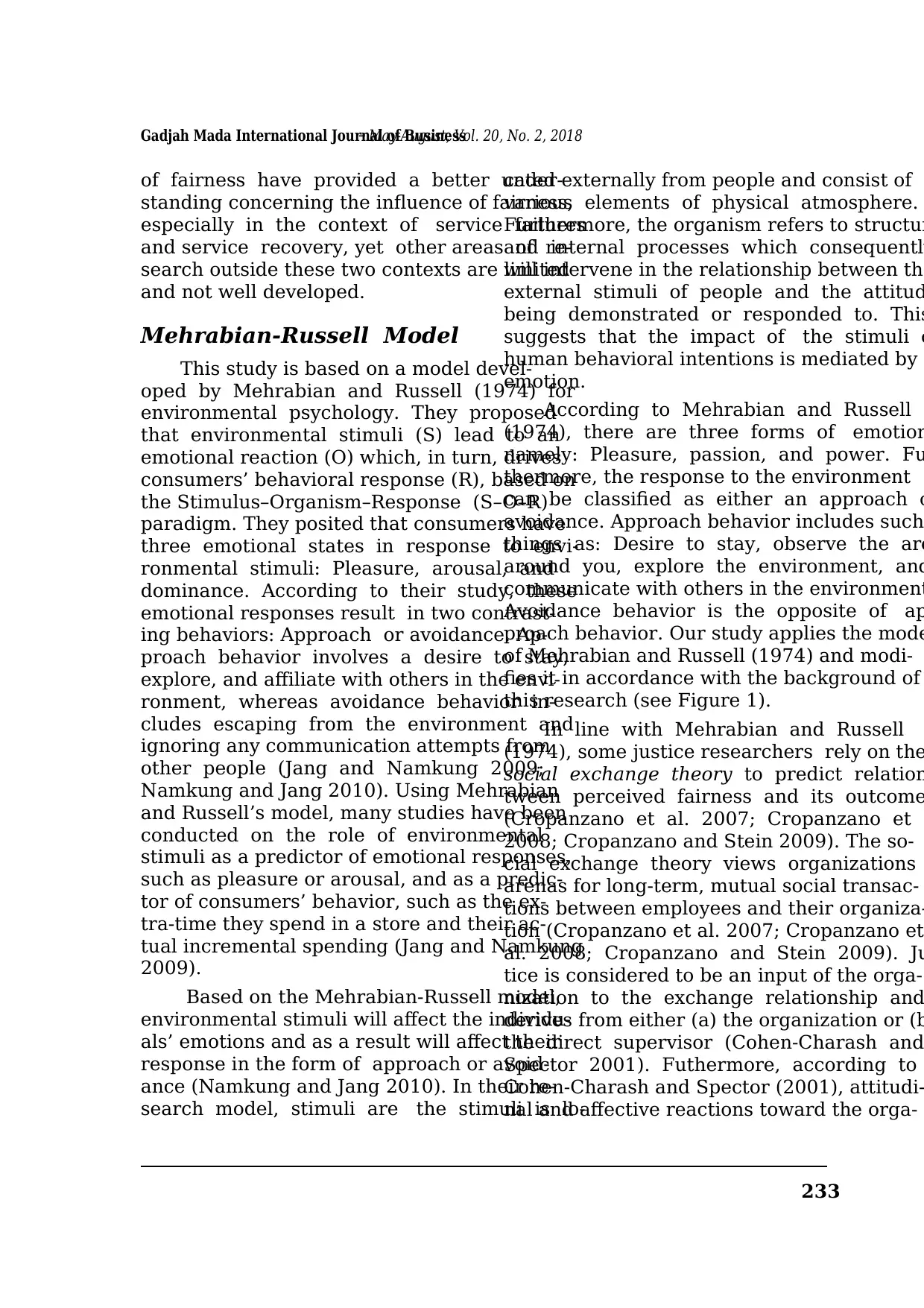
233
Gadjah Mada International Journal of Business– May-August, Vol. 20, No. 2, 2018
of fairness have provided a better under-
standing concerning the influence of fairness,
especially in the context of service failures
and service recovery, yet other areas of re-
search outside these two contexts are limited
and not well developed.
Mehrabian-Russell Model
This study is based on a model devel-
oped by Mehrabian and Russell (1974) for
environmental psychology. They proposed
that environmental stimuli (S) lead to an
emotional reaction (O) which, in turn, drives
consumers’ behavioral response (R), based on
the Stimulus–Organism–Response (S–O–R)
paradigm. They posited that consumers have
three emotional states in response to envi-
ronmental stimuli: Pleasure, arousal, and
dominance. According to their study, these
emotional responses result in two contrast-
ing behaviors: Approach or avoidance. Ap-
proach behavior involves a desire to stay,
explore, and affiliate with others in the envi-
ronment, whereas avoidance behavior in-
cludes escaping from the environment and
ignoring any communication attempts from
other people (Jang and Namkung 2009;
Namkung and Jang 2010). Using Mehrabian
and Russell’s model, many studies have been
conducted on the role of environmental
stimuli as a predictor of emotional responses,
such as pleasure or arousal, and as a predic-
tor of consumers’ behavior, such as the ex-
tra-time they spend in a store and their ac-
tual incremental spending (Jang and Namkung
2009).
Based on the Mehrabian-Russell model,
environmental stimuli will affect the individu-
als’ emotions and as a result will affect their
response in the form of approach or avoid-
ance (Namkung and Jang 2010). In their re-
search model, stimuli are the stimuli is lo-
cated externally from people and consist of
various elements of physical atmosphere.
Furthermore, the organism refers to structur
and internal processes which consequently
will intervene in the relationship between the
external stimuli of people and the attitud
being demonstrated or responded to. This
suggests that the impact of the stimuli o
human behavioral intentions is mediated by
emotion.
According to Mehrabian and Russell
(1974), there are three forms of emotion
namely: Pleasure, passion, and power. Fu
thermore, the response to the environment
can be classified as either an approach o
avoidance. Approach behavior includes such
things as: Desire to stay, observe the are
around you, explore the environment, and
communicate with others in the environment
Avoidance behavior is the opposite of ap
proach behavior. Our study applies the mode
of Mehrabian and Russell (1974) and modi-
fies it in accordance with the background of
this research (see Figure 1).
In line with Mehrabian and Russell
(1974), some justice researchers rely on the
social exchange theory to predict relation
tween perceived fairness and its outcome
(Cropanzano et al. 2007; Cropanzano et a
2008; Cropanzano and Stein 2009). The so-
cial exchange theory views organizations
arenas for long-term, mutual social transac-
tions between employees and their organiza-
tion (Cropanzano et al. 2007; Cropanzano et
al. 2008; Cropanzano and Stein 2009). Ju
tice is considered to be an input of the orga-
nization to the exchange relationship and
derives from either (a) the organization or (b
the direct supervisor (Cohen-Charash and
Spector 2001). Futhermore, according to
Cohen-Charash and Spector (2001), attitudi-
nal and affective reactions toward the orga-
Gadjah Mada International Journal of Business– May-August, Vol. 20, No. 2, 2018
of fairness have provided a better under-
standing concerning the influence of fairness,
especially in the context of service failures
and service recovery, yet other areas of re-
search outside these two contexts are limited
and not well developed.
Mehrabian-Russell Model
This study is based on a model devel-
oped by Mehrabian and Russell (1974) for
environmental psychology. They proposed
that environmental stimuli (S) lead to an
emotional reaction (O) which, in turn, drives
consumers’ behavioral response (R), based on
the Stimulus–Organism–Response (S–O–R)
paradigm. They posited that consumers have
three emotional states in response to envi-
ronmental stimuli: Pleasure, arousal, and
dominance. According to their study, these
emotional responses result in two contrast-
ing behaviors: Approach or avoidance. Ap-
proach behavior involves a desire to stay,
explore, and affiliate with others in the envi-
ronment, whereas avoidance behavior in-
cludes escaping from the environment and
ignoring any communication attempts from
other people (Jang and Namkung 2009;
Namkung and Jang 2010). Using Mehrabian
and Russell’s model, many studies have been
conducted on the role of environmental
stimuli as a predictor of emotional responses,
such as pleasure or arousal, and as a predic-
tor of consumers’ behavior, such as the ex-
tra-time they spend in a store and their ac-
tual incremental spending (Jang and Namkung
2009).
Based on the Mehrabian-Russell model,
environmental stimuli will affect the individu-
als’ emotions and as a result will affect their
response in the form of approach or avoid-
ance (Namkung and Jang 2010). In their re-
search model, stimuli are the stimuli is lo-
cated externally from people and consist of
various elements of physical atmosphere.
Furthermore, the organism refers to structur
and internal processes which consequently
will intervene in the relationship between the
external stimuli of people and the attitud
being demonstrated or responded to. This
suggests that the impact of the stimuli o
human behavioral intentions is mediated by
emotion.
According to Mehrabian and Russell
(1974), there are three forms of emotion
namely: Pleasure, passion, and power. Fu
thermore, the response to the environment
can be classified as either an approach o
avoidance. Approach behavior includes such
things as: Desire to stay, observe the are
around you, explore the environment, and
communicate with others in the environment
Avoidance behavior is the opposite of ap
proach behavior. Our study applies the mode
of Mehrabian and Russell (1974) and modi-
fies it in accordance with the background of
this research (see Figure 1).
In line with Mehrabian and Russell
(1974), some justice researchers rely on the
social exchange theory to predict relation
tween perceived fairness and its outcome
(Cropanzano et al. 2007; Cropanzano et a
2008; Cropanzano and Stein 2009). The so-
cial exchange theory views organizations
arenas for long-term, mutual social transac-
tions between employees and their organiza-
tion (Cropanzano et al. 2007; Cropanzano et
al. 2008; Cropanzano and Stein 2009). Ju
tice is considered to be an input of the orga-
nization to the exchange relationship and
derives from either (a) the organization or (b
the direct supervisor (Cohen-Charash and
Spector 2001). Futhermore, according to
Cohen-Charash and Spector (2001), attitudi-
nal and affective reactions toward the orga-
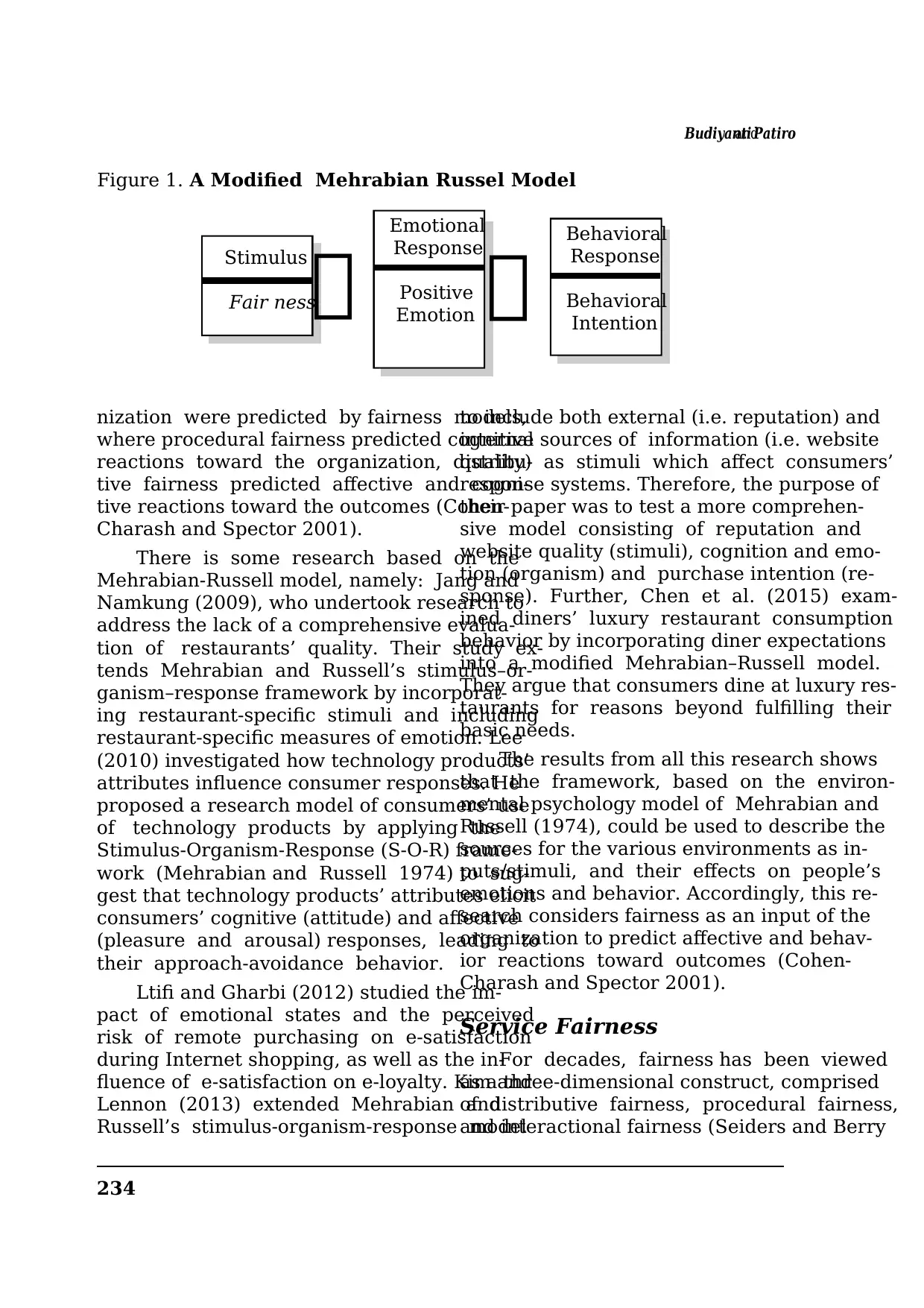
BudiyantiandPatiro
234
nization were predicted by fairness models,
where procedural fairness predicted cognitive
reactions toward the organization, distribu-
tive fairness predicted affective and cogni-
tive reactions toward the outcomes (Cohen-
Charash and Spector 2001).
There is some research based on the
Mehrabian-Russell model, namely: Jang and
Namkung (2009), who undertook research to
address the lack of a comprehensive evalua-
tion of restaurants’ quality. Their study ex-
tends Mehrabian and Russell’s stimulus–or-
ganism–response framework by incorporat-
ing restaurant-specific stimuli and including
restaurant-specific measures of emotion. Lee
(2010) investigated how technology products’
attributes influence consumer responses. He
proposed a research model of consumers’ use
of technology products by applying the
Stimulus-Organism-Response (S-O-R) frame-
work (Mehrabian and Russell 1974) to sug-
gest that technology products’ attributes elicit
consumers’ cognitive (attitude) and affective
(pleasure and arousal) responses, leading to
their approach-avoidance behavior.
Ltifi and Gharbi (2012) studied the im-
pact of emotional states and the perceived
risk of remote purchasing on e-satisfaction
during Internet shopping, as well as the in-
fluence of e-satisfaction on e-loyalty. Kim and
Lennon (2013) extended Mehrabian and
Russell’s stimulus-organism-response model
to include both external (i.e. reputation) and
internal sources of information (i.e. website
quality) as stimuli which affect consumers’
response systems. Therefore, the purpose of
their paper was to test a more comprehen-
sive model consisting of reputation and
website quality (stimuli), cognition and emo-
tion (organism) and purchase intention (re-
sponse). Further, Chen et al. (2015) exam-
ined diners’ luxury restaurant consumption
behavior by incorporating diner expectations
into a modified Mehrabian–Russell model.
They argue that consumers dine at luxury res-
taurants for reasons beyond fulfilling their
basic needs.
The results from all this research shows
that the framework, based on the environ-
mental psychology model of Mehrabian and
Russell (1974), could be used to describe the
sources for the various environments as in-
puts/stimuli, and their effects on people’s
emotions and behavior. Accordingly, this re-
search considers fairness as an input of the
organization to predict affective and behav-
ior reactions toward outcomes (Cohen-
Charash and Spector 2001).
Service Fairness
For decades, fairness has been viewed
as a three-dimensional construct, comprised
of distributive fairness, procedural fairness,
and interactional fairness (Seiders and Berry
Emotional
Response
Positive
Emotion
Behavioral
Response
Behavioral
Intention
Stimulus
Fair ness
Figure 1. A Modified Mehrabian Russel Model
234
nization were predicted by fairness models,
where procedural fairness predicted cognitive
reactions toward the organization, distribu-
tive fairness predicted affective and cogni-
tive reactions toward the outcomes (Cohen-
Charash and Spector 2001).
There is some research based on the
Mehrabian-Russell model, namely: Jang and
Namkung (2009), who undertook research to
address the lack of a comprehensive evalua-
tion of restaurants’ quality. Their study ex-
tends Mehrabian and Russell’s stimulus–or-
ganism–response framework by incorporat-
ing restaurant-specific stimuli and including
restaurant-specific measures of emotion. Lee
(2010) investigated how technology products’
attributes influence consumer responses. He
proposed a research model of consumers’ use
of technology products by applying the
Stimulus-Organism-Response (S-O-R) frame-
work (Mehrabian and Russell 1974) to sug-
gest that technology products’ attributes elicit
consumers’ cognitive (attitude) and affective
(pleasure and arousal) responses, leading to
their approach-avoidance behavior.
Ltifi and Gharbi (2012) studied the im-
pact of emotional states and the perceived
risk of remote purchasing on e-satisfaction
during Internet shopping, as well as the in-
fluence of e-satisfaction on e-loyalty. Kim and
Lennon (2013) extended Mehrabian and
Russell’s stimulus-organism-response model
to include both external (i.e. reputation) and
internal sources of information (i.e. website
quality) as stimuli which affect consumers’
response systems. Therefore, the purpose of
their paper was to test a more comprehen-
sive model consisting of reputation and
website quality (stimuli), cognition and emo-
tion (organism) and purchase intention (re-
sponse). Further, Chen et al. (2015) exam-
ined diners’ luxury restaurant consumption
behavior by incorporating diner expectations
into a modified Mehrabian–Russell model.
They argue that consumers dine at luxury res-
taurants for reasons beyond fulfilling their
basic needs.
The results from all this research shows
that the framework, based on the environ-
mental psychology model of Mehrabian and
Russell (1974), could be used to describe the
sources for the various environments as in-
puts/stimuli, and their effects on people’s
emotions and behavior. Accordingly, this re-
search considers fairness as an input of the
organization to predict affective and behav-
ior reactions toward outcomes (Cohen-
Charash and Spector 2001).
Service Fairness
For decades, fairness has been viewed
as a three-dimensional construct, comprised
of distributive fairness, procedural fairness,
and interactional fairness (Seiders and Berry
Emotional
Response
Positive
Emotion
Behavioral
Response
Behavioral
Intention
Stimulus
Fair ness
Figure 1. A Modified Mehrabian Russel Model
⊘ This is a preview!⊘
Do you want full access?
Subscribe today to unlock all pages.

Trusted by 1+ million students worldwide
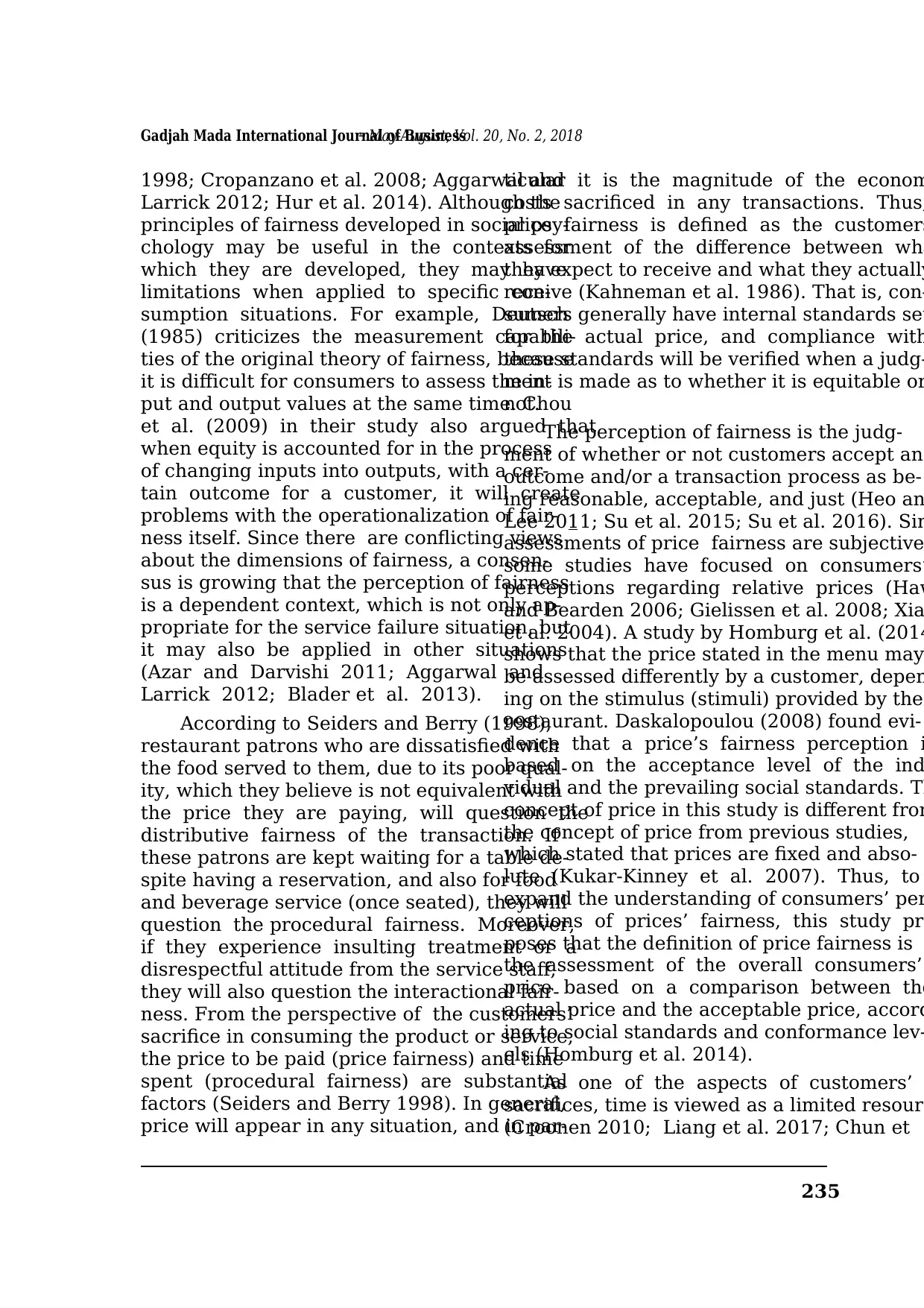
235
Gadjah Mada International Journal of Business– May-August, Vol. 20, No. 2, 2018
1998; Cropanzano et al. 2008; Aggarwal and
Larrick 2012; Hur et al. 2014). Although the
principles of fairness developed in social psy-
chology may be useful in the contexts for
which they are developed, they may have
limitations when applied to specific con-
sumption situations. For example, Deutsch
(1985) criticizes the measurement capabili-
ties of the original theory of fairness, because
it is difficult for consumers to assess the in-
put and output values at the same time. Chou
et al. (2009) in their study also argued that
when equity is accounted for in the process
of changing inputs into outputs, with a cer-
tain outcome for a customer, it will create
problems with the operationalization of fair-
ness itself. Since there are conflicting views
about the dimensions of fairness, a consen-
sus is growing that the perception of fairness
is a dependent context, which is not only ap-
propriate for the service failure situation, but
it may also be applied in other situations
(Azar and Darvishi 2011; Aggarwal and
Larrick 2012; Blader et al. 2013).
According to Seiders and Berry (1998),
restaurant patrons who are dissatisfied with
the food served to them, due to its poor qual-
ity, which they believe is not equivalent with
the price they are paying, will question the
distributive fairness of the transaction. If
these patrons are kept waiting for a table de-
spite having a reservation, and also for food
and beverage service (once seated), they will
question the procedural fairness. Moreover,
if they experience insulting treatment or a
disrespectful attitude from the service staff,
they will also question the interactional fair-
ness. From the perspective of the customers’
sacrifice in consuming the product or service,
the price to be paid (price fairness) and time
spent (procedural fairness) are substantial
factors (Seiders and Berry 1998). In general,
price will appear in any situation, and in par-
ticular it is the magnitude of the econom
costs sacrificed in any transactions. Thus,
price fairness is defined as the customers
assessment of the difference between wha
they expect to receive and what they actually
receive (Kahneman et al. 1986). That is, con-
sumers generally have internal standards set
for the actual price, and compliance with
these standards will be verified when a judg-
ment is made as to whether it is equitable or
not.
The perception of fairness is the judg-
ment of whether or not customers accept an
outcome and/or a transaction process as be-
ing reasonable, acceptable, and just (Heo an
Lee 2011; Su et al. 2015; Su et al. 2016). Sin
assessments of price fairness are subjective
some studies have focused on consumers’
perceptions regarding relative prices (Haw
and Bearden 2006; Gielissen et al. 2008; Xia
et al. 2004). A study by Homburg et al. (2014
shows that the price stated in the menu may
be assessed differently by a customer, depen
ing on the stimulus (stimuli) provided by the
restaurant. Daskalopoulou (2008) found evi-
dence that a price’s fairness perception i
based on the acceptance level of the ind
vidual and the prevailing social standards. Th
concept of price in this study is different from
the concept of price from previous studies,
which stated that prices are fixed and abso-
lute (Kukar-Kinney et al. 2007). Thus, to
expand the understanding of consumers’ per
ceptions of prices’ fairness, this study pro
poses that the definition of price fairness is
the assessment of the overall consumers’
price based on a comparison between the
actual price and the acceptable price, accord
ing to social standards and conformance lev-
els (Homburg et al. 2014).
As one of the aspects of customers’
sacrifices, time is viewed as a limited resourc
(Croonen 2010; Liang et al. 2017; Chun et
Gadjah Mada International Journal of Business– May-August, Vol. 20, No. 2, 2018
1998; Cropanzano et al. 2008; Aggarwal and
Larrick 2012; Hur et al. 2014). Although the
principles of fairness developed in social psy-
chology may be useful in the contexts for
which they are developed, they may have
limitations when applied to specific con-
sumption situations. For example, Deutsch
(1985) criticizes the measurement capabili-
ties of the original theory of fairness, because
it is difficult for consumers to assess the in-
put and output values at the same time. Chou
et al. (2009) in their study also argued that
when equity is accounted for in the process
of changing inputs into outputs, with a cer-
tain outcome for a customer, it will create
problems with the operationalization of fair-
ness itself. Since there are conflicting views
about the dimensions of fairness, a consen-
sus is growing that the perception of fairness
is a dependent context, which is not only ap-
propriate for the service failure situation, but
it may also be applied in other situations
(Azar and Darvishi 2011; Aggarwal and
Larrick 2012; Blader et al. 2013).
According to Seiders and Berry (1998),
restaurant patrons who are dissatisfied with
the food served to them, due to its poor qual-
ity, which they believe is not equivalent with
the price they are paying, will question the
distributive fairness of the transaction. If
these patrons are kept waiting for a table de-
spite having a reservation, and also for food
and beverage service (once seated), they will
question the procedural fairness. Moreover,
if they experience insulting treatment or a
disrespectful attitude from the service staff,
they will also question the interactional fair-
ness. From the perspective of the customers’
sacrifice in consuming the product or service,
the price to be paid (price fairness) and time
spent (procedural fairness) are substantial
factors (Seiders and Berry 1998). In general,
price will appear in any situation, and in par-
ticular it is the magnitude of the econom
costs sacrificed in any transactions. Thus,
price fairness is defined as the customers
assessment of the difference between wha
they expect to receive and what they actually
receive (Kahneman et al. 1986). That is, con-
sumers generally have internal standards set
for the actual price, and compliance with
these standards will be verified when a judg-
ment is made as to whether it is equitable or
not.
The perception of fairness is the judg-
ment of whether or not customers accept an
outcome and/or a transaction process as be-
ing reasonable, acceptable, and just (Heo an
Lee 2011; Su et al. 2015; Su et al. 2016). Sin
assessments of price fairness are subjective
some studies have focused on consumers’
perceptions regarding relative prices (Haw
and Bearden 2006; Gielissen et al. 2008; Xia
et al. 2004). A study by Homburg et al. (2014
shows that the price stated in the menu may
be assessed differently by a customer, depen
ing on the stimulus (stimuli) provided by the
restaurant. Daskalopoulou (2008) found evi-
dence that a price’s fairness perception i
based on the acceptance level of the ind
vidual and the prevailing social standards. Th
concept of price in this study is different from
the concept of price from previous studies,
which stated that prices are fixed and abso-
lute (Kukar-Kinney et al. 2007). Thus, to
expand the understanding of consumers’ per
ceptions of prices’ fairness, this study pro
poses that the definition of price fairness is
the assessment of the overall consumers’
price based on a comparison between the
actual price and the acceptable price, accord
ing to social standards and conformance lev-
els (Homburg et al. 2014).
As one of the aspects of customers’
sacrifices, time is viewed as a limited resourc
(Croonen 2010; Liang et al. 2017; Chun et
Paraphrase This Document
Need a fresh take? Get an instant paraphrase of this document with our AI Paraphraser
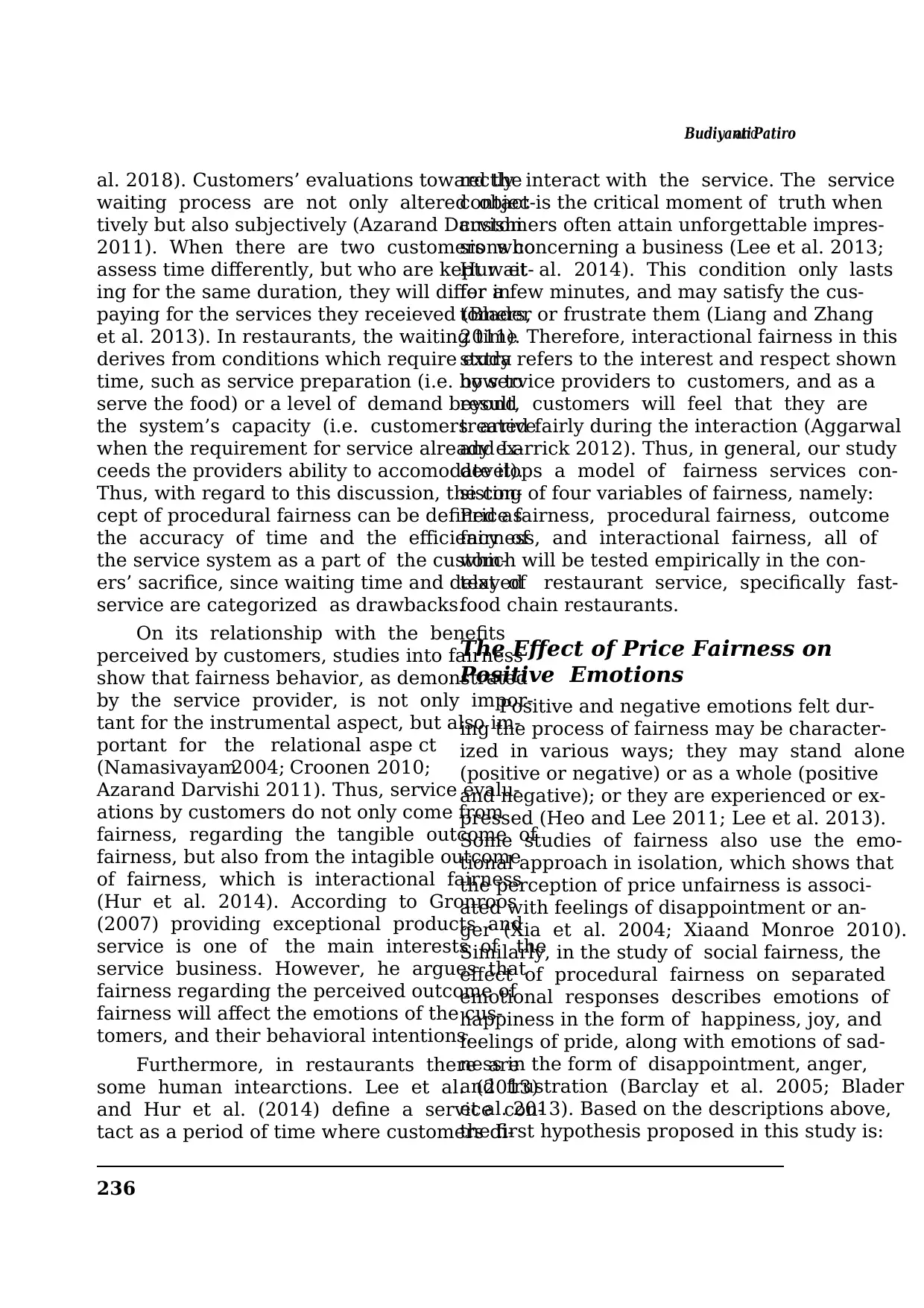
BudiyantiandPatiro
236
al. 2018). Customers’ evaluations toward the
waiting process are not only altered objec-
tively but also subjectively (Azarand Darvishi
2011). When there are two customers who
assess time differently, but who are kept wait-
ing for the same duration, they will differ in
paying for the services they receieved (Blader
et al. 2013). In restaurants, the waiting time
derives from conditions which require extra
time, such as service preparation (i.e. how to
serve the food) or a level of demand beyond
the system’s capacity (i.e. customers arrive
when the requirement for service already ex-
ceeds the providers ability to accomodate it).
Thus, with regard to this discussion, the con-
cept of procedural fairness can be defined as
the accuracy of time and the efficiency of
the service system as a part of the custom-
ers’ sacrifice, since waiting time and delayed
service are categorized as drawbacks.
On its relationship with the benefits
perceived by customers, studies into fairness
show that fairness behavior, as demonstrated
by the service provider, is not only impor-
tant for the instrumental aspect, but also im-
portant for the relational aspe ct
(Namasivayam2004; Croonen 2010;
Azarand Darvishi 2011). Thus, service evalu-
ations by customers do not only come from
fairness, regarding the tangible outcome of
fairness, but also from the intagible outcome
of fairness, which is interactional fairness
(Hur et al. 2014). According to Gronroos
(2007) providing exceptional products and
service is one of the main interests of the
service business. However, he argues that
fairness regarding the perceived outcome of
fairness will affect the emotions of the cus-
tomers, and their behavioral intentions.
Furthermore, in restaurants there are
some human intearctions. Lee et al. (2013)
and Hur et al. (2014) define a service con-
tact as a period of time where customers di-
rectly interact with the service. The service
contact is the critical moment of truth when
customers often attain unforgettable impres-
sions concerning a business (Lee et al. 2013;
Hur et al. 2014). This condition only lasts
for a few minutes, and may satisfy the cus-
tomers, or frustrate them (Liang and Zhang
2011). Therefore, interactional fairness in this
study refers to the interest and respect shown
by service providers to customers, and as a
result, customers will feel that they are
treated fairly during the interaction (Aggarwal
and Larrick 2012). Thus, in general, our study
develops a model of fairness services con-
sisting of four variables of fairness, namely:
Price fairness, procedural fairness, outcome
fairness, and interactional fairness, all of
which will be tested empirically in the con-
text of restaurant service, specifically fast-
food chain restaurants.
The Effect of Price Fairness on
Positive Emotions
Positive and negative emotions felt dur-
ing the process of fairness may be character-
ized in various ways; they may stand alone
(positive or negative) or as a whole (positive
and negative); or they are experienced or ex-
pressed (Heo and Lee 2011; Lee et al. 2013).
Some studies of fairness also use the emo-
tional approach in isolation, which shows that
the perception of price unfairness is associ-
ated with feelings of disappointment or an-
ger (Xia et al. 2004; Xiaand Monroe 2010).
Similarly, in the study of social fairness, the
effect of procedural fairness on separated
emotional responses describes emotions of
happiness in the form of happiness, joy, and
feelings of pride, along with emotions of sad-
ness in the form of disappointment, anger,
and frustration (Barclay et al. 2005; Blader
et al. 2013). Based on the descriptions above,
the first hypothesis proposed in this study is:
236
al. 2018). Customers’ evaluations toward the
waiting process are not only altered objec-
tively but also subjectively (Azarand Darvishi
2011). When there are two customers who
assess time differently, but who are kept wait-
ing for the same duration, they will differ in
paying for the services they receieved (Blader
et al. 2013). In restaurants, the waiting time
derives from conditions which require extra
time, such as service preparation (i.e. how to
serve the food) or a level of demand beyond
the system’s capacity (i.e. customers arrive
when the requirement for service already ex-
ceeds the providers ability to accomodate it).
Thus, with regard to this discussion, the con-
cept of procedural fairness can be defined as
the accuracy of time and the efficiency of
the service system as a part of the custom-
ers’ sacrifice, since waiting time and delayed
service are categorized as drawbacks.
On its relationship with the benefits
perceived by customers, studies into fairness
show that fairness behavior, as demonstrated
by the service provider, is not only impor-
tant for the instrumental aspect, but also im-
portant for the relational aspe ct
(Namasivayam2004; Croonen 2010;
Azarand Darvishi 2011). Thus, service evalu-
ations by customers do not only come from
fairness, regarding the tangible outcome of
fairness, but also from the intagible outcome
of fairness, which is interactional fairness
(Hur et al. 2014). According to Gronroos
(2007) providing exceptional products and
service is one of the main interests of the
service business. However, he argues that
fairness regarding the perceived outcome of
fairness will affect the emotions of the cus-
tomers, and their behavioral intentions.
Furthermore, in restaurants there are
some human intearctions. Lee et al. (2013)
and Hur et al. (2014) define a service con-
tact as a period of time where customers di-
rectly interact with the service. The service
contact is the critical moment of truth when
customers often attain unforgettable impres-
sions concerning a business (Lee et al. 2013;
Hur et al. 2014). This condition only lasts
for a few minutes, and may satisfy the cus-
tomers, or frustrate them (Liang and Zhang
2011). Therefore, interactional fairness in this
study refers to the interest and respect shown
by service providers to customers, and as a
result, customers will feel that they are
treated fairly during the interaction (Aggarwal
and Larrick 2012). Thus, in general, our study
develops a model of fairness services con-
sisting of four variables of fairness, namely:
Price fairness, procedural fairness, outcome
fairness, and interactional fairness, all of
which will be tested empirically in the con-
text of restaurant service, specifically fast-
food chain restaurants.
The Effect of Price Fairness on
Positive Emotions
Positive and negative emotions felt dur-
ing the process of fairness may be character-
ized in various ways; they may stand alone
(positive or negative) or as a whole (positive
and negative); or they are experienced or ex-
pressed (Heo and Lee 2011; Lee et al. 2013).
Some studies of fairness also use the emo-
tional approach in isolation, which shows that
the perception of price unfairness is associ-
ated with feelings of disappointment or an-
ger (Xia et al. 2004; Xiaand Monroe 2010).
Similarly, in the study of social fairness, the
effect of procedural fairness on separated
emotional responses describes emotions of
happiness in the form of happiness, joy, and
feelings of pride, along with emotions of sad-
ness in the form of disappointment, anger,
and frustration (Barclay et al. 2005; Blader
et al. 2013). Based on the descriptions above,
the first hypothesis proposed in this study is:
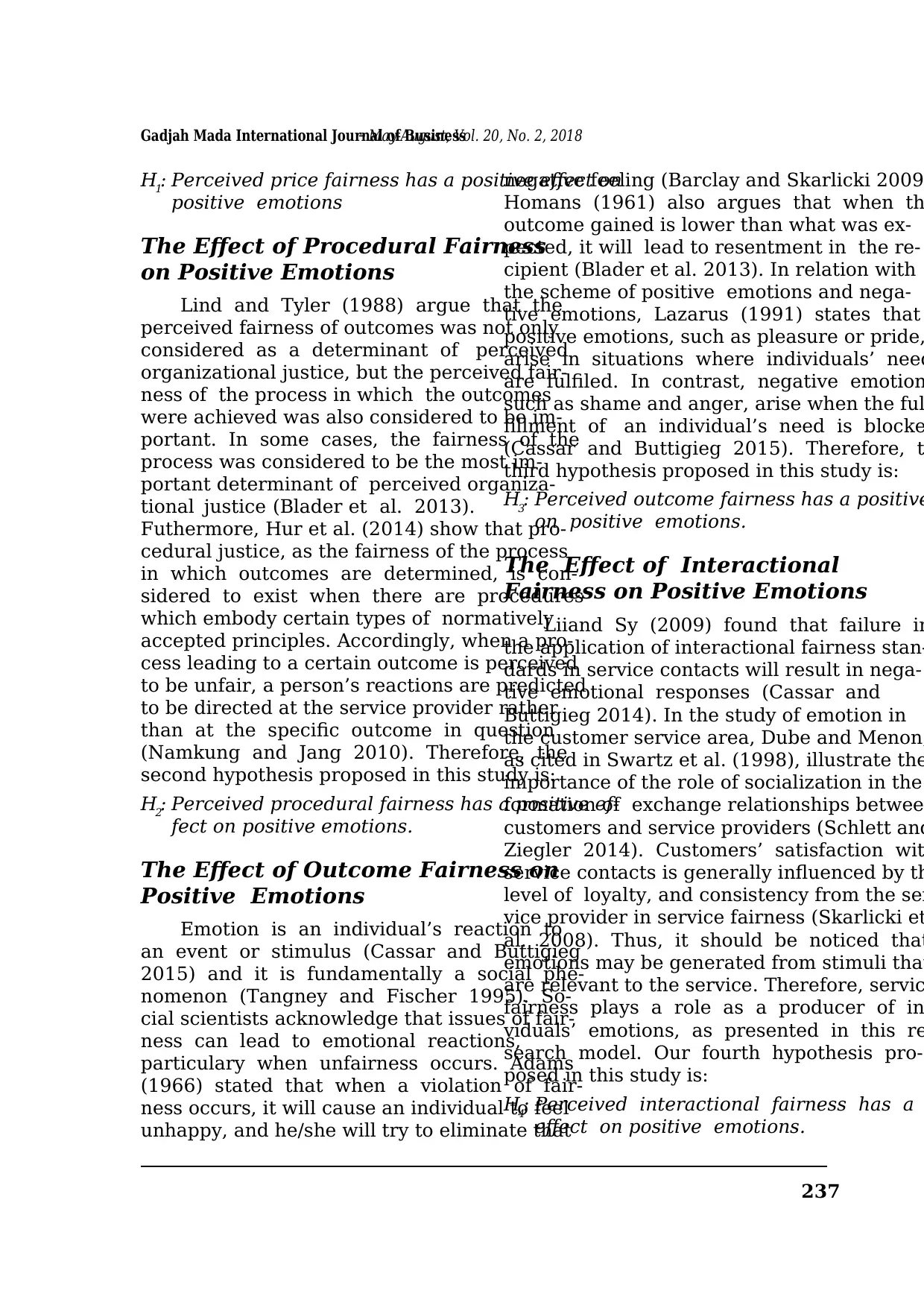
237
Gadjah Mada International Journal of Business– May-August, Vol. 20, No. 2, 2018
H1: Perceived price fairness has a positive effect on
positive emotions
The Effect of Procedural Fairness
on Positive Emotions
Lind and Tyler (1988) argue that the
perceived fairness of outcomes was not only
considered as a determinant of perceived
organizational justice, but the perceived fair-
ness of the process in which the outcomes
were achieved was also considered to be im-
portant. In some cases, the fairness of the
process was considered to be the most im-
portant determinant of perceived organiza-
tional justice (Blader et al. 2013).
Futhermore, Hur et al. (2014) show that pro-
cedural justice, as the fairness of the process
in which outcomes are determined, is con-
sidered to exist when there are procedures
which embody certain types of normatively
accepted principles. Accordingly, when a pro-
cess leading to a certain outcome is perceived
to be unfair, a person’s reactions are predicted
to be directed at the service provider rather
than at the specific outcome in question
(Namkung and Jang 2010). Therefore, the
second hypothesis proposed in this study is:
H2: Perceived procedural fairness has a positive ef-
fect on positive emotions.
The Effect of Outcome Fairness on
Positive Emotions
Emotion is an individual’s reaction to
an event or stimulus (Cassar and Buttigieg
2015) and it is fundamentally a social phe-
nomenon (Tangney and Fischer 1995). So-
cial scientists acknowledge that issues of fair-
ness can lead to emotional reactions,
particulary when unfairness occurs. Adams
(1966) stated that when a violation of fair-
ness occurs, it will cause an individual to feel
unhappy, and he/she will try to eliminate that
negative feeling (Barclay and Skarlicki 2009
Homans (1961) also argues that when th
outcome gained is lower than what was ex-
pected, it will lead to resentment in the re-
cipient (Blader et al. 2013). In relation with
the scheme of positive emotions and nega-
tive emotions, Lazarus (1991) states that
positive emotions, such as pleasure or pride,
arise in situations where individuals’ need
are fulfiled. In contrast, negative emotion
such as shame and anger, arise when the ful
fillment of an individual’s need is blocke
(Cassar and Buttigieg 2015). Therefore, t
third hypothesis proposed in this study is:
H3: Perceived outcome fairness has a positive
on positive emotions.
The Effect of Interactional
Fairness on Positive Emotions
Liiand Sy (2009) found that failure in
the application of interactional fairness stan-
dards in service contacts will result in nega-
tive emotional responses (Cassar and
Buttigieg 2014). In the study of emotion in
the customer service area, Dube and Menon,
as cited in Swartz et al. (1998), illustrate the
importance of the role of socialization in the
formation of exchange relationships betwee
customers and service providers (Schlett and
Ziegler 2014). Customers’ satisfaction wit
service contacts is generally influenced by th
level of loyalty, and consistency from the ser
vice provider in service fairness (Skarlicki et
al. 2008). Thus, it should be noticed that
emotions may be generated from stimuli that
are relevant to the service. Therefore, servic
fairness plays a role as a producer of in
viduals’ emotions, as presented in this re
search model. Our fourth hypothesis pro-
posed in this study is:
H4: Perceived interactional fairness has a
effect on positive emotions.
Gadjah Mada International Journal of Business– May-August, Vol. 20, No. 2, 2018
H1: Perceived price fairness has a positive effect on
positive emotions
The Effect of Procedural Fairness
on Positive Emotions
Lind and Tyler (1988) argue that the
perceived fairness of outcomes was not only
considered as a determinant of perceived
organizational justice, but the perceived fair-
ness of the process in which the outcomes
were achieved was also considered to be im-
portant. In some cases, the fairness of the
process was considered to be the most im-
portant determinant of perceived organiza-
tional justice (Blader et al. 2013).
Futhermore, Hur et al. (2014) show that pro-
cedural justice, as the fairness of the process
in which outcomes are determined, is con-
sidered to exist when there are procedures
which embody certain types of normatively
accepted principles. Accordingly, when a pro-
cess leading to a certain outcome is perceived
to be unfair, a person’s reactions are predicted
to be directed at the service provider rather
than at the specific outcome in question
(Namkung and Jang 2010). Therefore, the
second hypothesis proposed in this study is:
H2: Perceived procedural fairness has a positive ef-
fect on positive emotions.
The Effect of Outcome Fairness on
Positive Emotions
Emotion is an individual’s reaction to
an event or stimulus (Cassar and Buttigieg
2015) and it is fundamentally a social phe-
nomenon (Tangney and Fischer 1995). So-
cial scientists acknowledge that issues of fair-
ness can lead to emotional reactions,
particulary when unfairness occurs. Adams
(1966) stated that when a violation of fair-
ness occurs, it will cause an individual to feel
unhappy, and he/she will try to eliminate that
negative feeling (Barclay and Skarlicki 2009
Homans (1961) also argues that when th
outcome gained is lower than what was ex-
pected, it will lead to resentment in the re-
cipient (Blader et al. 2013). In relation with
the scheme of positive emotions and nega-
tive emotions, Lazarus (1991) states that
positive emotions, such as pleasure or pride,
arise in situations where individuals’ need
are fulfiled. In contrast, negative emotion
such as shame and anger, arise when the ful
fillment of an individual’s need is blocke
(Cassar and Buttigieg 2015). Therefore, t
third hypothesis proposed in this study is:
H3: Perceived outcome fairness has a positive
on positive emotions.
The Effect of Interactional
Fairness on Positive Emotions
Liiand Sy (2009) found that failure in
the application of interactional fairness stan-
dards in service contacts will result in nega-
tive emotional responses (Cassar and
Buttigieg 2014). In the study of emotion in
the customer service area, Dube and Menon,
as cited in Swartz et al. (1998), illustrate the
importance of the role of socialization in the
formation of exchange relationships betwee
customers and service providers (Schlett and
Ziegler 2014). Customers’ satisfaction wit
service contacts is generally influenced by th
level of loyalty, and consistency from the ser
vice provider in service fairness (Skarlicki et
al. 2008). Thus, it should be noticed that
emotions may be generated from stimuli that
are relevant to the service. Therefore, servic
fairness plays a role as a producer of in
viduals’ emotions, as presented in this re
search model. Our fourth hypothesis pro-
posed in this study is:
H4: Perceived interactional fairness has a
effect on positive emotions.
⊘ This is a preview!⊘
Do you want full access?
Subscribe today to unlock all pages.

Trusted by 1+ million students worldwide
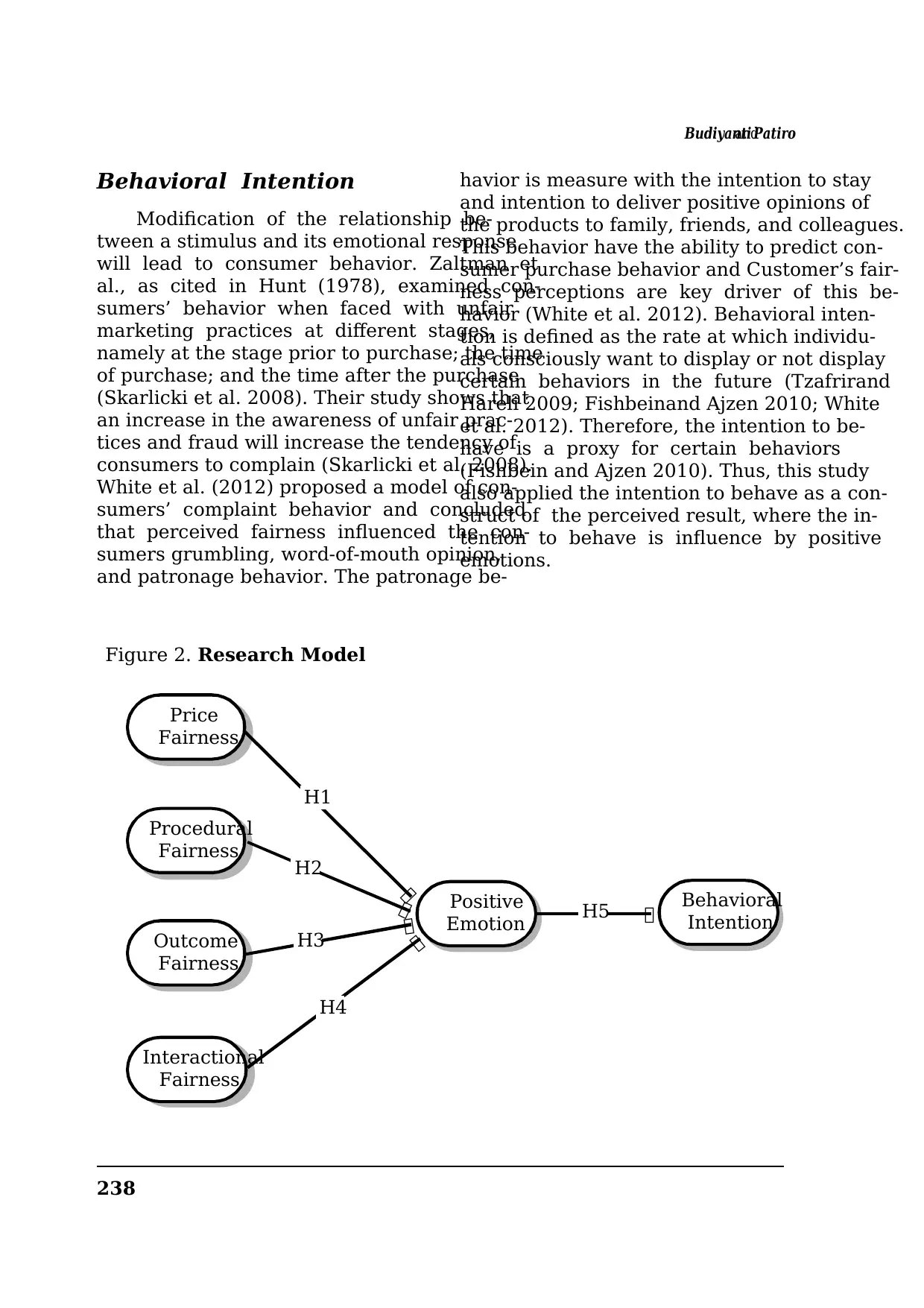
BudiyantiandPatiro
238
Behavioral Intention
Modification of the relationship be-
tween a stimulus and its emotional response
will lead to consumer behavior. Zaltman et
al., as cited in Hunt (1978), examined con-
sumers’ behavior when faced with unfair
marketing practices at different stages,
namely at the stage prior to purchase; the time
of purchase; and the time after the purchase
(Skarlicki et al. 2008). Their study shows that
an increase in the awareness of unfair prac-
tices and fraud will increase the tendency of
consumers to complain (Skarlicki et al. 2008).
White et al. (2012) proposed a model of con-
sumers’ complaint behavior and concluded
that perceived fairness influenced the con-
sumers grumbling, word-of-mouth opinion,
and patronage behavior. The patronage be-
havior is measure with the intention to stay
and intention to deliver positive opinions of
the products to family, friends, and colleagues.
This behavior have the ability to predict con-
sumer purchase behavior and Customer’s fair-
ness perceptions are key driver of this be-
havior (White et al. 2012). Behavioral inten-
tion is defined as the rate at which individu-
als consciously want to display or not display
certain behaviors in the future (Tzafrirand
Hareli 2009; Fishbeinand Ajzen 2010; White
et al. 2012). Therefore, the intention to be-
have is a proxy for certain behaviors
(Fishbein and Ajzen 2010). Thus, this study
also applied the intention to behave as a con-
struct of the perceived result, where the in-
tention to behave is influence by positive
emotions.
Figure 2. Research Model
Procedural
Fairness
Price
Fairness
Outcome
Fairness
Interactional
Fairness
Positive
Emotion
Behavioral
Intention
H1
H2
H3
H4
H5
238
Behavioral Intention
Modification of the relationship be-
tween a stimulus and its emotional response
will lead to consumer behavior. Zaltman et
al., as cited in Hunt (1978), examined con-
sumers’ behavior when faced with unfair
marketing practices at different stages,
namely at the stage prior to purchase; the time
of purchase; and the time after the purchase
(Skarlicki et al. 2008). Their study shows that
an increase in the awareness of unfair prac-
tices and fraud will increase the tendency of
consumers to complain (Skarlicki et al. 2008).
White et al. (2012) proposed a model of con-
sumers’ complaint behavior and concluded
that perceived fairness influenced the con-
sumers grumbling, word-of-mouth opinion,
and patronage behavior. The patronage be-
havior is measure with the intention to stay
and intention to deliver positive opinions of
the products to family, friends, and colleagues.
This behavior have the ability to predict con-
sumer purchase behavior and Customer’s fair-
ness perceptions are key driver of this be-
havior (White et al. 2012). Behavioral inten-
tion is defined as the rate at which individu-
als consciously want to display or not display
certain behaviors in the future (Tzafrirand
Hareli 2009; Fishbeinand Ajzen 2010; White
et al. 2012). Therefore, the intention to be-
have is a proxy for certain behaviors
(Fishbein and Ajzen 2010). Thus, this study
also applied the intention to behave as a con-
struct of the perceived result, where the in-
tention to behave is influence by positive
emotions.
Figure 2. Research Model
Procedural
Fairness
Price
Fairness
Outcome
Fairness
Interactional
Fairness
Positive
Emotion
Behavioral
Intention
H1
H2
H3
H4
H5
Paraphrase This Document
Need a fresh take? Get an instant paraphrase of this document with our AI Paraphraser
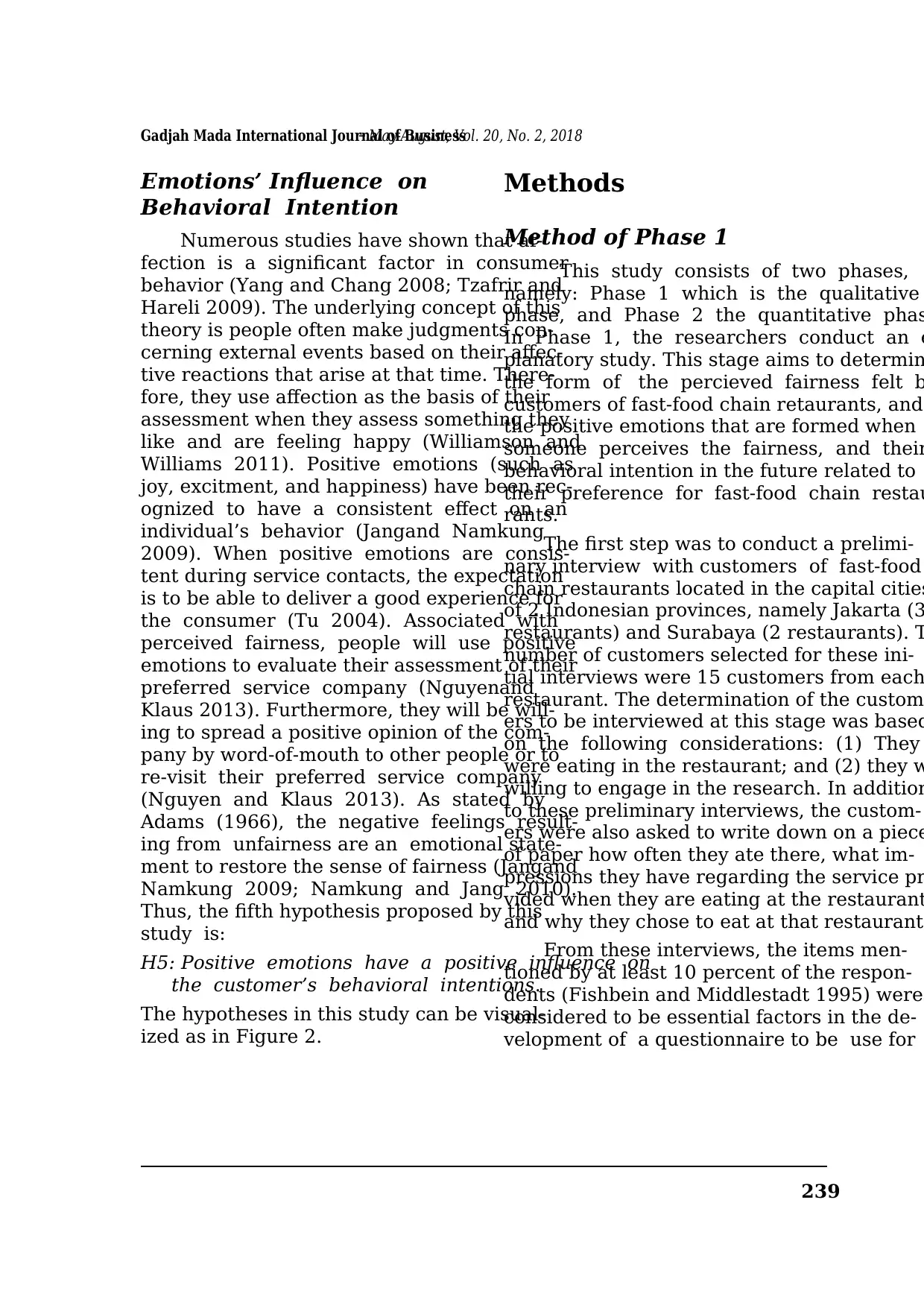
239
Gadjah Mada International Journal of Business– May-August, Vol. 20, No. 2, 2018
Emotions’ Influence on
Behavioral Intention
Numerous studies have shown that af-
fection is a significant factor in consumer
behavior (Yang and Chang 2008; Tzafrir and
Hareli 2009). The underlying concept of this
theory is people often make judgments con-
cerning external events based on their affec-
tive reactions that arise at that time. There-
fore, they use affection as the basis of their
assessment when they assess something they
like and are feeling happy (Williamson and
Williams 2011). Positive emotions (such as
joy, excitment, and happiness) have been rec-
ognized to have a consistent effect on an
individual’s behavior (Jangand Namkung
2009). When positive emotions are consis-
tent during service contacts, the expectation
is to be able to deliver a good experience for
the consumer (Tu 2004). Associated with
perceived fairness, people will use positive
emotions to evaluate their assessment of their
preferred service company (Nguyenand
Klaus 2013). Furthermore, they will be will-
ing to spread a positive opinion of the com-
pany by word-of-mouth to other people or to
re-visit their preferred service company
(Nguyen and Klaus 2013). As stated by
Adams (1966), the negative feelings result-
ing from unfairness are an emotional state-
ment to restore the sense of fairness (Jangand
Namkung 2009; Namkung and Jang 2010).
Thus, the fifth hypothesis proposed by this
study is:
H5: Positive emotions have a positive influence on
the customer’s behavioral intentions.
The hypotheses in this study can be visual-
ized as in Figure 2.
Methods
Method of Phase 1
This study consists of two phases,
namely: Phase 1 which is the qualitative
phase, and Phase 2 the quantitative phas
In Phase 1, the researchers conduct an e
planatory study. This stage aims to determin
the form of the percieved fairness felt b
customers of fast-food chain retaurants, and
the positive emotions that are formed when
someone perceives the fairness, and their
behavioral intention in the future related to
their preference for fast-food chain restau
rants.
The first step was to conduct a prelimi-
nary interview with customers of fast-food
chain restaurants located in the capital cities
of 2 Indonesian provinces, namely Jakarta (3
restaurants) and Surabaya (2 restaurants). T
number of customers selected for these ini-
tial interviews were 15 customers from each
restaurant. The determination of the custom
ers to be interviewed at this stage was based
on the following considerations: (1) They
were eating in the restaurant; and (2) they w
willing to engage in the research. In addition
to these preliminary interviews, the custom-
ers were also asked to write down on a piece
of paper how often they ate there, what im-
pressions they have regarding the service pr
vided when they are eating at the restaurant
and why they chose to eat at that restaurant.
From these interviews, the items men-
tioned by at least 10 percent of the respon-
dents (Fishbein and Middlestadt 1995) were
considered to be essential factors in the de-
velopment of a questionnaire to be use for
Gadjah Mada International Journal of Business– May-August, Vol. 20, No. 2, 2018
Emotions’ Influence on
Behavioral Intention
Numerous studies have shown that af-
fection is a significant factor in consumer
behavior (Yang and Chang 2008; Tzafrir and
Hareli 2009). The underlying concept of this
theory is people often make judgments con-
cerning external events based on their affec-
tive reactions that arise at that time. There-
fore, they use affection as the basis of their
assessment when they assess something they
like and are feeling happy (Williamson and
Williams 2011). Positive emotions (such as
joy, excitment, and happiness) have been rec-
ognized to have a consistent effect on an
individual’s behavior (Jangand Namkung
2009). When positive emotions are consis-
tent during service contacts, the expectation
is to be able to deliver a good experience for
the consumer (Tu 2004). Associated with
perceived fairness, people will use positive
emotions to evaluate their assessment of their
preferred service company (Nguyenand
Klaus 2013). Furthermore, they will be will-
ing to spread a positive opinion of the com-
pany by word-of-mouth to other people or to
re-visit their preferred service company
(Nguyen and Klaus 2013). As stated by
Adams (1966), the negative feelings result-
ing from unfairness are an emotional state-
ment to restore the sense of fairness (Jangand
Namkung 2009; Namkung and Jang 2010).
Thus, the fifth hypothesis proposed by this
study is:
H5: Positive emotions have a positive influence on
the customer’s behavioral intentions.
The hypotheses in this study can be visual-
ized as in Figure 2.
Methods
Method of Phase 1
This study consists of two phases,
namely: Phase 1 which is the qualitative
phase, and Phase 2 the quantitative phas
In Phase 1, the researchers conduct an e
planatory study. This stage aims to determin
the form of the percieved fairness felt b
customers of fast-food chain retaurants, and
the positive emotions that are formed when
someone perceives the fairness, and their
behavioral intention in the future related to
their preference for fast-food chain restau
rants.
The first step was to conduct a prelimi-
nary interview with customers of fast-food
chain restaurants located in the capital cities
of 2 Indonesian provinces, namely Jakarta (3
restaurants) and Surabaya (2 restaurants). T
number of customers selected for these ini-
tial interviews were 15 customers from each
restaurant. The determination of the custom
ers to be interviewed at this stage was based
on the following considerations: (1) They
were eating in the restaurant; and (2) they w
willing to engage in the research. In addition
to these preliminary interviews, the custom-
ers were also asked to write down on a piece
of paper how often they ate there, what im-
pressions they have regarding the service pr
vided when they are eating at the restaurant
and why they chose to eat at that restaurant.
From these interviews, the items men-
tioned by at least 10 percent of the respon-
dents (Fishbein and Middlestadt 1995) were
considered to be essential factors in the de-
velopment of a questionnaire to be use for
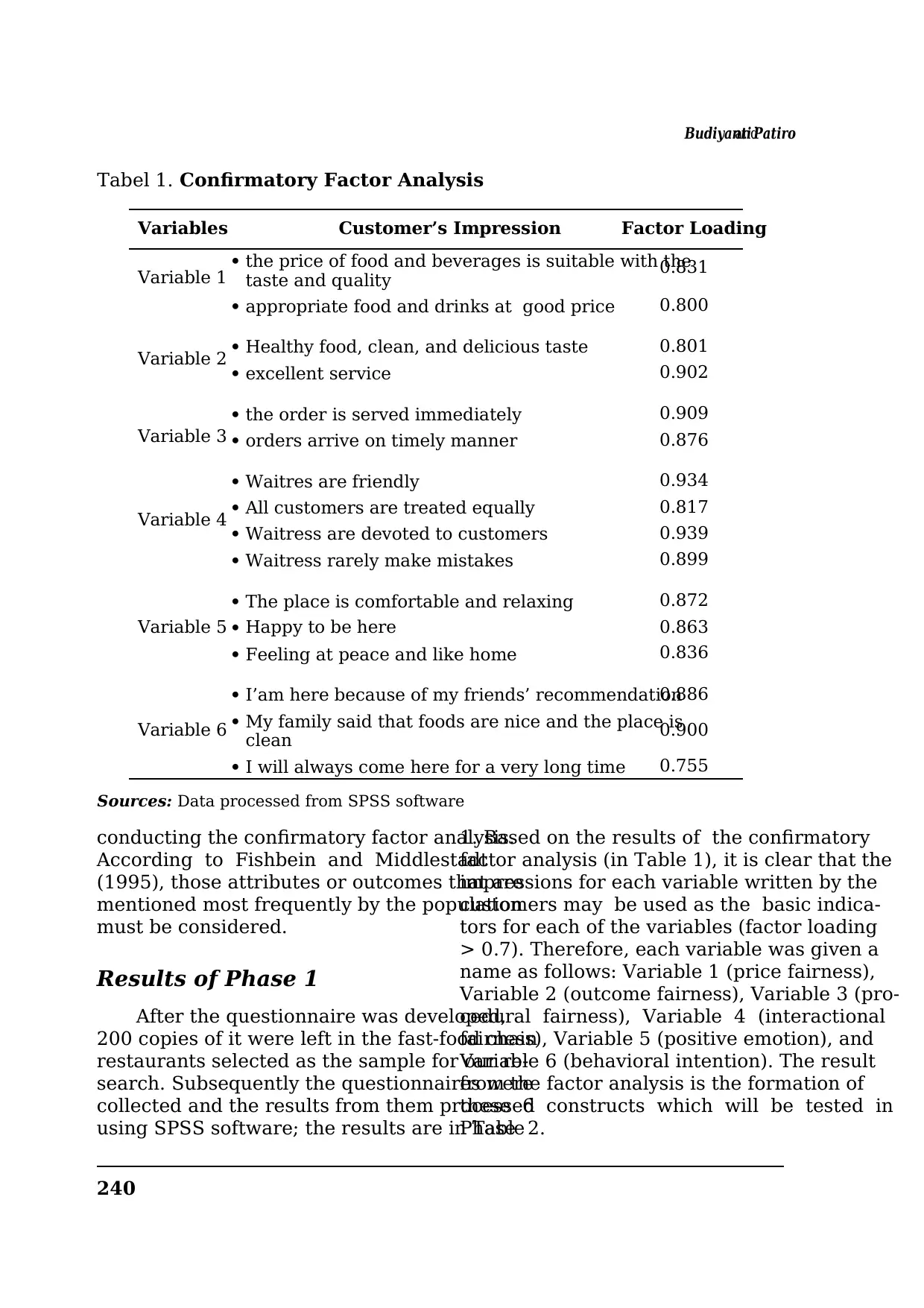
BudiyantiandPatiro
240
conducting the confirmatory factor analysis.
According to Fishbein and Middlestadt
(1995), those attributes or outcomes that are
mentioned most frequently by the population
must be considered.
Results of Phase 1
After the questionnaire was developed,
200 copies of it were left in the fast-food chain
restaurants selected as the sample for our re-
search. Subsequently the questionnaires were
collected and the results from them processed
using SPSS software; the results are in Table
1. Based on the results of the confirmatory
factor analysis (in Table 1), it is clear that the
impressions for each variable written by the
customers may be used as the basic indica-
tors for each of the variables (factor loading
> 0.7). Therefore, each variable was given a
name as follows: Variable 1 (price fairness),
Variable 2 (outcome fairness), Variable 3 (pro-
cedural fairness), Variable 4 (interactional
fairness), Variable 5 (positive emotion), and
Variable 6 (behavioral intention). The result
from the factor analysis is the formation of
these 6 constructs which will be tested in
Phase 2.
Variables Customer’s Impression Factor Loading
Variable 1 the price of food and beverages is suitable with the
taste and quality 0.831
appropriate food and drinks at good price 0.800
Variable 2 Healthy food, clean, and delicious taste 0.801
excellent service 0.902
Variable 3
the order is served immediately 0.909
orders arrive on timely manner 0.876
Variable 4
Waitres are friendly 0.934
All customers are treated equally 0.817
Waitress are devoted to customers 0.939
Waitress rarely make mistakes 0.899
Variable 5
The place is comfortable and relaxing 0.872
Happy to be here 0.863
Feeling at peace and like home 0.836
Variable 6
I’am here because of my friends’ recommendation0.886
My family said that foods are nice and the place is
clean 0.900
I will always come here for a very long time 0.755
Tabel 1. Confirmatory Factor Analysis
Sources: Data processed from SPSS software
240
conducting the confirmatory factor analysis.
According to Fishbein and Middlestadt
(1995), those attributes or outcomes that are
mentioned most frequently by the population
must be considered.
Results of Phase 1
After the questionnaire was developed,
200 copies of it were left in the fast-food chain
restaurants selected as the sample for our re-
search. Subsequently the questionnaires were
collected and the results from them processed
using SPSS software; the results are in Table
1. Based on the results of the confirmatory
factor analysis (in Table 1), it is clear that the
impressions for each variable written by the
customers may be used as the basic indica-
tors for each of the variables (factor loading
> 0.7). Therefore, each variable was given a
name as follows: Variable 1 (price fairness),
Variable 2 (outcome fairness), Variable 3 (pro-
cedural fairness), Variable 4 (interactional
fairness), Variable 5 (positive emotion), and
Variable 6 (behavioral intention). The result
from the factor analysis is the formation of
these 6 constructs which will be tested in
Phase 2.
Variables Customer’s Impression Factor Loading
Variable 1 the price of food and beverages is suitable with the
taste and quality 0.831
appropriate food and drinks at good price 0.800
Variable 2 Healthy food, clean, and delicious taste 0.801
excellent service 0.902
Variable 3
the order is served immediately 0.909
orders arrive on timely manner 0.876
Variable 4
Waitres are friendly 0.934
All customers are treated equally 0.817
Waitress are devoted to customers 0.939
Waitress rarely make mistakes 0.899
Variable 5
The place is comfortable and relaxing 0.872
Happy to be here 0.863
Feeling at peace and like home 0.836
Variable 6
I’am here because of my friends’ recommendation0.886
My family said that foods are nice and the place is
clean 0.900
I will always come here for a very long time 0.755
Tabel 1. Confirmatory Factor Analysis
Sources: Data processed from SPSS software
⊘ This is a preview!⊘
Do you want full access?
Subscribe today to unlock all pages.

Trusted by 1+ million students worldwide
1 out of 26
Your All-in-One AI-Powered Toolkit for Academic Success.
+13062052269
info@desklib.com
Available 24*7 on WhatsApp / Email
![[object Object]](/_next/static/media/star-bottom.7253800d.svg)
Unlock your academic potential
Copyright © 2020–2025 A2Z Services. All Rights Reserved. Developed and managed by ZUCOL.


